Centauri Dreams
Imagining and Planning Interstellar Exploration
SETI’s Charismatic Megafauna
The search for technosignatures that could flag the presence of extraterrestrial cultures has accelerated in recent times with projects like Glimpsing Heat from Alien Technologies at Penn State and numerous papers. Or is the better term not ‘cultures’ but ‘societies,’ or ‘civilizations’? SETI’s funding challenges, at least from government agencies, point to the need for defining its terms in ways that NASA, for example, can live with. Nick Nielsen examines the question in today’s essay, probing the issue of terminology in relation to public support, and noting the ongoing effort to evaluate and revise how SETI is described. Nielsen, a frequent Centauri Dreams contributor and a member of the board of directors for Icarus Interstellar, is a prolific writer who tracks these and other space-related issues in Grand Strategy: The View from Oregon, and Grand Strategy Annex.
by J. N. Nielsen
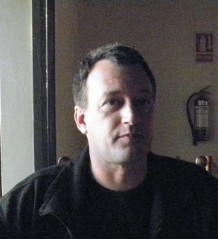
Recently there have been some signs that NASA may consider a rapprochement with SETI and SETI scientists, after more than twenty years of a de facto NASA ban on funding SETI (cf. NASA Renews Interest in SETI by David Grinspoon). It’s not yet clear how far this rapprochement will extend, but NASA did lend its name to the NASA Technosignatures Workshop (NTW18) last September. The event webpage names the Lunar and Planetary Institute, Universities Space Research Association, and National Aeronautics and Space Administration as having provided “institutional support”; I do not know if this involved financial support from NASA. The recent NASA Technosignatures Workshop also resulted in a 70 page paper, “NASA and the Search for Technosignatures: A Report from the NASA Technosignatures Workshop.”
I have to wonder if the term “technosignatures” is ultimately more palatable than the acronym “SETI,” with the latter’s explicit reference to ETI (extraterrestrial intelligence). “Technosignatures” sounds tech-savvy and doesn’t explicitly invoke aliens, though the idea of aliens is still there implicitly as a presupposition. This may sound like an overly-subtle gloss on the situation, but it is still a significant consideration. It is conceivable that NASA eventually will consider funding projects that mention “technosignatures” while continuing to pass over any project that mentions “SETI.”
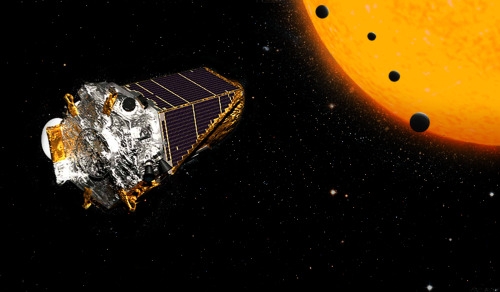
The need to re-brand SETI was discussed in ‘Search for Extraterrestrial Intelligence’ Needs a New Name, SETI Pioneer Says by Calla Cofield, primarily discussing the recent work of SETI notable Jill Tarter. The author attributes to Tarter the idea that the acronym “SETI,” and what it has come to signify, “…generates an incorrect perception of what scientists in this field are actually doing.” Tarter also discusses the need for terminology reform. The question of SETI terminology has come in for a lot of discussion lately. We have seen the explicit consideration of SETI terminology in Wright’s paper “Taxonomy and Jargon in SETI as an Interdisciplinary Field of Study” and in the collective effort “Recommendations from the Ad Hoc Committee on SETI Nomenclature” by Jason T. Wright, Sofia Sheikh, Iván Almár, Kathryn Denning, Steven Dick, and Jill Tarter.
I found myself rather annoyed by the second of the two papers named in the paragraph above (I will henceforth call it the “Recommendations paper”), because it failed to deal with the hard conceptual problems presented by the terminology commonly used, and the hardest problems are usually the most interesting problems once you buckle down and focus on them with a will to really understand what is going on. Usually one finds that vague and imprecise terms paper over a multitude of subtle meanings, easily conflated, and it is a lot of work—sometimes tedious work—to separate out all these threads and give a full accounting of the ideas that are the background of the natural language employed in a science before that science is fully formalized.
Early analytical philosophers had a word for this clarification that has sadly fallen out of use: explication; take a look at Chapter 1 of Carnap’s Logical Foundations of Probability, “On Explication,” for a detailed exposition of explication. Carnap’s conception of explication could provide a framework for thinking about the explication of concepts employed in SETI. It was disappointing to me that the Recommendations paper is a laundry list of terms to use and terms to avoid, but, in fairness to the authors, the remit of the ad hoc committee was, “…to recommend standardized definitions for terms,” and not a root-and-branch re-thinking of the conceptual foundations of the discipline (which is what I would have liked to have seen).
Of particular interest to me in the Recommendations paper was its treatment of “civilization”:
Civilization
In a SETI context, e.g. (extraterrestrial or alien civilization) usually synonymous with technological species. Use with care.
Notes: The term civilization has imprecise popular meanings, but also particular scholarly meanings in relation to human history that are not generally what is meant by the term in a SETI context. Because of its ambiguity and anthropocentrism, the term is a suboptimal synonym for technological species, but it is nonetheless widely used in the literature. Society is a good alternative but not yet in common use.
It could be pointed out that “society” also has both imprecise popular meanings and particular scholarly meanings, so it is difficult to say how “society” is any better in this respect than “civilization.” I also question the idea that “technological species” is in any sense more precise or any less ambiguous than “civilization.”
The authors of the paper note that the use of “civilization” in SETI differs from its use in other scholarly contexts, but they don’t seem to be at all interested in why this is the case, or in finding some conception of civilization that is non-anthropocentric and is equally suitable for use in SETI and other sciences. This would be like someone saying that “BTU” is used to indicate energy in heating and “watt” is used to indicate energy in electricity, but that there is no need for any common conception of energy that might be an umbrella conception for BTU and watt (or calorie, or joule, etc.).
The same paper takes on the use of the term “advanced,” and while I agree that the term “advanced” is problematic, it is not problematic for the reasons cited in the paper. “Advanced” in isolation means nothing; it is a relational term. What would make sense is a formulation such as “x is more advanced than y.” With a little refinement we get, “x is a more advanced F than y.” Now, this latter formulation could be said to be in the same spirit as the recommendation in the paper of, “…simply specifying the scale or nature of the technology referenced.” I’m on board with this, as long as it is made clear that “advanced” is a relational term that is meaningless in isolation. What we find in most cases of using “advanced” in isolation is that the comparison is implicit; one of the virtues of formalizing any usage in a schema such as, “x is a more advanced F than y,” is that it forces us to make our assumptions explicit.
Clearly, however, the authors of the Recommendations paper mean to condemn, “…deprecated theories of human history which rank human societies from ‘primitive’ to ‘advanced’ based on ill-defined and ethnocentric measures.” No doubt the authors have the most virtuous motives for condemning what they see as ethnocentric measures to distinguish primitive from advanced civilizations, but—Alas!—science is unconcerned with the virtue of its practitioners, or the lack thereof. We could go a long way toward improving the situation by offering a precisely defined scale by which civilizations could be rank-ordered, but I doubt that this would quell the misgivings of those whose concern is addressing the grievances claimed to follow from ethnocentric bias. I will say no more at present regarding this.
In addition to his advocacy for SETI terminology reform, Jason Wright has also argued strongly that SETI is and ought to be a part of astrobiology (cf. “SETI is Part of Astrobiology”). Wright counters the official NASA line that, “Traditional SETI is not part of astrobiology,” by arguing that some of the most obvious signs of terrestrial habitability are Earth’s technosignatures. Wright also points out that NASA arbitrarily excludes technosignatures from “traditional SETI.” Obviously, to the extent that NASA’s exclusion is arbitrary, it is dissatisfying. Given that NASA has been deeply involved with astrobiology since its inception (cf. The Living Universe: NASA and the Development of Astrobiology by Steven J. Dick and James E. Strick, which discusses NASA’s involvement in astrobiology since the term was introduced), if SETI is part of astrobiology, and NASA was present at the foundations of astrobiology, then the case could be made that NASA’s astrobiology program should include SETI as an integral component, organically present ab initio. That is to say, SETI is not some foreign body that has become inexplicably lodged in astrobiology.
However, in a Twitter post, Jason Wright referenced two posts by Dr. Linda Billings, SETI: on the edge of astrobiology and Astrobiology and SETI: different evolutionary pathways, which argue against including SETI under the umbrella of astrobiology. These posts conclude, respectively, “The bottom line is that traditional SETI—using ground-based radio telescopes to listen for signals of extraterrestrial intelligent origin—falls outside the boundaries of NASA’s astrobiology program.” And, “…the history/evolution of exo/astrobiology more closely parallels the history/evolution of planetary protection. Exo/astrobiology and SETI evolved on very different, non-parallel tracks.” Thus the argument whether SETI ought to be considered a part of astrobiology has been made both in the affirmative and in the negative. It seems pretty weak to me to argue that SETI is intrinsically about ground-based observations, as SETI observations from space-based telescopes would be a great boost for the discipline, if only these resources were made available to SETI research. Wright deals with this weakness as one of the erroneous perceptions he identifies that has led to the exclusion of SETI from NASA’s astrobiology portfolio.
Much of this discussion is taking place because SETI is poorly funded, and if government monies were made available to SETI researchers, the discipline could pursue a more ambitious scientific research program. But because SETI has been largely frozen out of government funding through NASA, which would be its natural home (unless, like Billings, we see the National Science Foundation funded ground-based telescopes as the natural home of SETI), SETI funding efforts have taken creative forms. One of these creative ways of doing SETI science on the cheap has been projects that can be described as “parasitic,” “piggyback,” and “opportunistic.” This was taken up explicitly by Jill Tarter in 1984 in “Parasitic, Piggyback and Opportunistic SETI: It’s Cheap and It Just Might Work?”
A year prior, in 1983, the idea was already floated in “The Berkeley parasitic SETI program” by S. Bowyer, G. Zeitlin, J. Tarter, M. Lampton, and W. J. Welch. And since then we have seen, “The SERENDIP piggyback SETI project” by M. Lampton, S. Bowyer, D. Werthimer, C. Donnelly, and W. Herrick (1992) and “An Opportunistic Search for ExtraTerrestrial Intelligence (SETI) with the Murchison Widefield Array” by S. J. Tingay, C. Tremblay, A. Walsh, and R. Urquhart (2016). The latter paper characterizes their “opportunistic” SETI as follows:
“In this Letter, we present a first, and opportunistic, SETI pilot experiment with the MWA, in the frequency range 103–133 MHz, placing limits on narrow band radio emission toward 38 known planetary systems. The experiment is opportunistic in the sense that the observations were undertaken for a spectral line survey of the Galactic Plane that is ongoing; utility of the data for a SETI experiment was realised post-observation.”
There is a kind of subtle irony in SETI science having to operate parasitically on other projects deemed more fundable, or, at least, projects that would not draw the ire of politicians looking for a soft budgetary target to attack. Arguably, whatever public support that there is for space exploration (and however correct or mistaken it may be to connect space exploration with SETI), derives from the hope, perhaps even the titillating hope, of finding something “out there” that would mean that we are not alone.
I have often said that any excitement over things like exoplanet searches always turns on whether the planets are habitable, any excitement over whether the planet is habitable largely turns on whether we can ever determine whether or not these planets actually have life, any excitement over whether or not we can determine if these planets have life largely turns on whether that life could be intelligent, and any excitement over whether or not this life could be intelligent largely turns on whether we might possibly communicate with or travel to these intelligent beings. Space science, then, is to a large extent an artifact of our cosmic loneliness, and our desire to mitigate that cosmic loneliness.
I’ve read a few candid comments to this effect (I can’t remember the source), and I have no doubt that this is the case. In the same way that conservation biology has an easier time raising money to fight for charismatic megafauna, but has a much more difficult time raising money based on conservation efforts for unattractive animals or very small animals, so too space science efforts do better when they are related to some “sexy” space science topic like aliens?—?but this has to be done sotto voce, with a wink and a nudge, because NASA, to be taken seriously, must keep up the appearance of high seriousness. NASA’s budgetary choices are held hostage by the “giggle factor.”
In a sense, then, it is space science that is parasitic upon SETI and human spaceflight (which appeals as a source of national pride in accomplishment), which, when the latter dominated NASA and NASA’s budget, took the lion’s share of the money and left little for space science. In recent decades, the focus has been more on space science, and so it is SETI (rather than prestige) which is the unspoken background to what is going on explicitly in the foreground. While I care deeply about space science, and I know how much NASA’s space science programs have transformed our knowledge of the universe, few in the wider public share my sentiments, and they cannot be expected to so share these sentiments. But they can share an interest in the “charismatic megafauna” of astrobiology, which are the intelligent aliens that SETI is seeking.
If NASA can embrace technosignatures as a part of astrobiology, it may find a way to excite the interest of the public while maintaining its scientific respectability. And if that requires a shift in terminology, I suspect that SETI researchers will be ready to make that shift. An article by Lisa Grossman, It’s time to start taking the search for E.T. seriously, astronomers say: Some scientists are pushing for NASA to make looking for alien technology an official goal, notes that Jason Wright is part of a group of scientists who are actively seeking to have the search for technosignatures incorporated into NASA’s next Decadal Survey, which, if successful, would mean federal funding for SETI projects. Everyone is well aware that such funding would transform the discipline, and SETI advocates are now actively campaigning for the funding.
We can already see this transition to the language of technosignatures taking place. For example, if we take as a recent example the paper, “A search for technosignatures from TRAPPIST-1, LHS 1140, and 10 planetary systems in the Kepler field with the Green Bank Telescope at 1.15-1.73 GHz” by Pavlo Pinchuk, et al., we find that “technosignatures” are mentioned repeatedly throughout the text, “extraterrestrial” is mentioned ten times, “SETI” is mentioned a couple of times (as well as in the bibliography, in an internet address, and in a title), “civilization” is mentioned once, and “alien” appears nowhere in the document.
Any scientific discipline, as it evolves, eventually revises its terminology, as it usually begins with imprecise terms taken from ordinary language and eventually settles upon more formalized usages that are defined with scientific precision, and which become the accepted jargon of the discipline. There is scientific precision in spades to be found in SETI research papers. What is wanting in SETI (and in discussions of technosignatures, for that matter) is the conceptual framework within which these terms are formulated. SETI science is strong, but its concepts are often weak and ambiguous, as is evidenced by the recent concern with terminology. I have had this conceptual weakness on my mind for some time, and I hope to be able to write more about this as I clarify my own thoughts on the matter. Others seem to have noted this weakness as well. In a paper that has just come out by Jim Pass of the Astrosociology Research Institute, Exo-Astrosociology and the Search for Technosignatures, Pass notes:
“Unlike with the regard to discoveries associated with the search for biosignatures mostly in our Solar System, which have produced discoveries and insights of tangible value, the research associated with the search for technosignatures is less impressive.”
The charismatic megafauna of SETI—little green men, space aliens, Martians, and their kin—are emblematic of this conceptual weakness, and they could be made more respectable with a prolonged inquiry into and clarification of the conceptual framework within which we discuss the possibility of the emergent complexities we know on Earth—life, sentience, consciousness, intelligence, mind, technology, and civilization, inter alia — also existing elsewhere. If we have gotten the sequence of emergent complexities right, this sequence begins with biology, and so is initially an astrobiological inquiry. However, at some point it becomes an inquiry larger than astrobiology (or, if you prefer, an inquiry no longer narrowly contained within the boundaries of biological thought), and our conceptual framework must expand in order to accommodate this larger domain of inquiry. Explication, then, could play a crucial role in exorcising space aliens and replacing them with a theoretical construction more consonant with NASA’s demand for high seriousness.

Perspectives Beyond the Moon
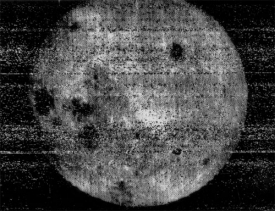
Today we re-enter the realm of perspective-altering photographs, images that open new vistas in our early reconnaissance of the Solar System. Before October 7, 1959, we had little knowledge of the far side of the Moon, even though librations allowed the occasional glimpse at extremely low angles of a small part of it. The Soviet moon probe Luna 3 took the first photographs of the far side, and was followed by the much better imagery of Zond 3 in 1965. NASA’s Lunar Orbiter program would continue the mapping as the 1960s progressed.
Image: First glimpse. The view of the Moon’s far side from Luna 3.
The far side would swim into vivid focus, of course, when Apollo 8 and subsequent missions took astronauts to the Moon, but it was up to the China National Space Administration to make the first soft landing there on January 3 of this year (Ranger 4 had impacted on the far side in 1962, but without returning data before impact). Working in this environment demanded a relay satellite to support communications with the Chang’e 4 mission on the surface.
The Queqiao satellite handles signals from the surface and relays them to Earth, working with a satellite called Longjiang-2, from which the image below was downloaded on February 3. Remember, for most of human history, we had no idea what the far side of the Moon looked like. Now we’ve not only mapped it, but can see a view of Earth with the entire far side laid out before us.
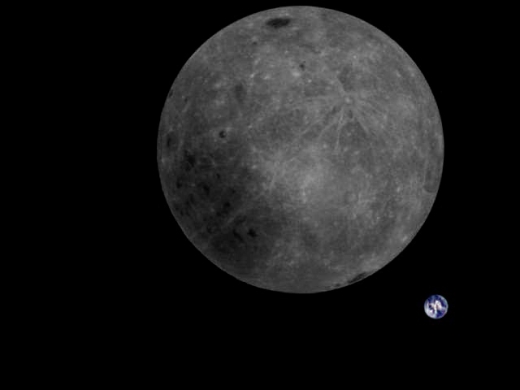
Image: Downloaded at the Dwingeloo Radio Observatory in the Netherlands, this view from Longjiang-2 shows the Earth and the Moon’s far side. The contrast in color is reminiscent of Bill Anders’ famous shot from Apollo 8, though here we see the Moon in its entirety.
Another perspective changer is the fact that Longjiang-2 is equipped with an amateur radio transceiver that allows radio amateurs to downlink telemetry and relay messages through it, as well as commanding it to take and downlink images, as explained in this page at the Dwingeloo website. What an opportunity for space-minded amateurs. They can work Longjiang-2 (call sign BJ1SN) and join the amateur team at Dwingeloo itself (PI9CAM) to see images that, not all that long ago, would have seemed astonishing. For many of us, ‘astonishing’ still applies.
I can’t leave the far side without comparing the above to the animation below, a spectacular shot of of the Earth and Moon as seen by the DSCOVR satellite (Deep Space Climate Observatory).
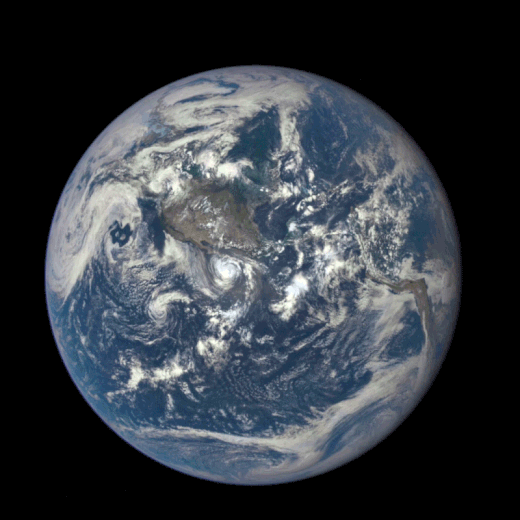
Image: This animation features satellite images of the far side of the Moon, illuminated by the Sun, as it crosses between the DSCOVR spacecraft’s Earth Polychromatic Imaging Camera (EPIC) and telescope, and the Earth — 1.6 million km (1 million miles) away. The times of the images span from 3:50 p.m. to 8:45 p.m. EDT on July 16, 2015. The time of the New Moon was at 9:26 p.m. EDT on July 15. Credit: NASA/NOAA.
Another perspective enhancer is the view below from MARCO-B, nicknamed WALL-E. Along with MARCO-A (also known as EVE), the CubeSat made it to Mars in a seven-month journey that provided data on the InSight landing on November 26, 2018. The data were valuable because Mars orbiters could not observe the entire landing sequence and route information swiftly back to Earth. The MARCOs returned data at each stage of the InSight descent and landing in near-real time, also beaming back InSight’s first image.
And despite the failure of MARCO-A’s camera, MARCO-B succeeded in fine fashion with the memorable animation below.
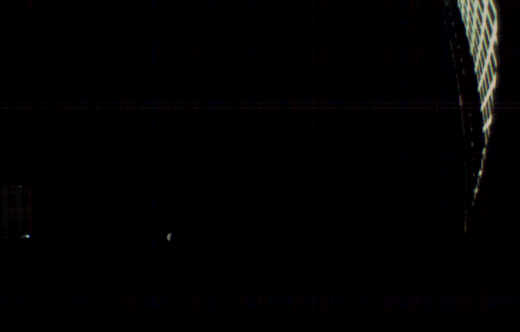
Image: MARCO-B, one of the experimental Mars Cube One (MARCO) CubeSats, took the images shown in the animation above as it approached Mars from about 575,000 kilometers (357,300 miles) to 18,000 kilometers (11,200 miles) away, just before NASA’s InSight spacecraft landed on Mars on Nov. 26, 2018. MARCO-B flew by Mars with its twin, MARCO-A, to serve as communications relays for InSight as it touched down on the Red Planet. Nicknamed WALL-E, MARCO-B took these images on Sunday, Nov. 25 and Monday, Nov. 26, 2018. The bright point of light to the left is the corner of MARCO-B’s high gain antenna feed and to the right is the high gain antenna, which let the CubeSat communicate with Earth. In this animation, Mars is spinning on its axis from right to left. Credit: NASA/JPL-Caltech.
There have been no further transmissions from MARCO-B since the end of December, while we last heard from MARCO-A in early January. We have this from JPL:
The mission team has several theories for why they haven’t been able to contact the pair. WALL-E has a leaky thruster. Attitude-control issues could be causing them to wobble and lose the ability to send and receive commands. The brightness sensors that allow the CubeSats to stay pointed at the Sun and recharge their batteries could be another factor. The MarCOs are in orbit around the Sun and will only get farther away as February wears on. The farther they are, the more precisely they need to point their antennas to communicate with Earth.
This summer the two diminutive spacecraft will begin moving back toward the Sun. MARCO-A is, based on calculations of its trajectory, now more than 3.2 million kilometers beyond Mars, while MARCO-B is 1.6 million kilometers past the planet. Further attempts to communicate with the CubeSats will be made later this year, but it’s not known how long the batteries and other parts of the spacecraft will last. Whether we hear from either again or not, the MARCOs have pushed the paradigms of size and cost and pointed the way to future missions, perhaps one day involving solar sails and networking technologies taken all the way to the outer planets.

Refining the Shape of the Milky Way
Figuring out the shape of things — where to place what we see in the sky in a 3-D representation — has always been challenging. We’re looking out at a disk of stars from well within it, and it wasn’t until the 1920s and the work of Edwin Hubble that we began to see there were other such disks, not nebulae at all but galaxies in their own right, some bigger than ours. Interestingly, Immanuel Kant had speculated about this as far back as 1755.
About our own galaxy, we still have much to learn, as I am once again reminded by a paper by authors from Macquarie University (Australia) and the Chinese Academy of Sciences. The Milky Way turns out to be not as flat as many depictions would have us believe. In fact, our galaxy shows distinct signs of warping, a spiral pattern that appears to be the result of torque produced by the Milky Way’s massive inner disk of closely packed stars.
In the outer regions of the galaxy’s neutral hydrogen disk, the warp becomes readily apparent. We wind up with a shape something like the one in this artist’s impression below:
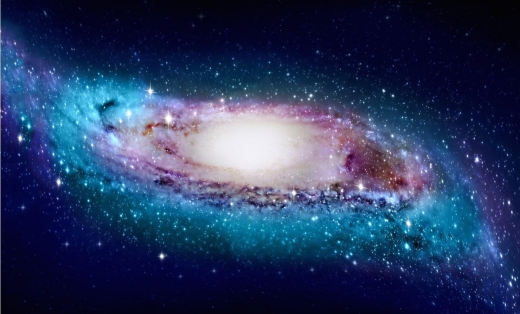
Image: A slightly exaggerated impression of the real shape of our warped and twisted Milky Way. Credit: Xiaodian Chen (National Astronomical Observatories, Chinese Academy of Sciences).
The twisted spiral pattern is hardly unique to the Milky Way. In fact, about a dozen other galaxies are known to display such patterns.
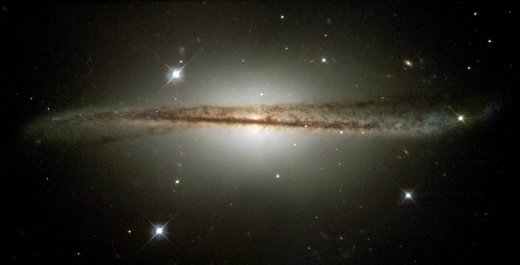
Image: The galaxy ESO 510-G13 is an edge-on warped spiral galaxy. Similar to the Milky Way it has a pronounced warp in its gaseous disc and a less pronounced warp in its disc of stars. Credit: NASA/Space Telescope Science Institute.
Demonstrating a spiral pattern from within the galaxy under study is not easy, says lead author Xiaodian Chen (Chinese Academy of Sciences, Beijing):
“It is notoriously difficult to determine distances from the Sun to parts of the Milky Way’s outer gas disc without having a clear idea of what that disc actually looks like. However, we recently published a new catalogue of well-behaved variable stars known as classical Cepheids, for which very accurate distances can be determined with an error of only three to five per cent.”
Using Cepheid variables found in data from the Wide-field Infrared Survey Explorer (WISE) mission as well as a variety of optical surveys, the researchers set about producing a three-dimensional picture of the galaxy out to its farthest regions. Cepheid variables are helpful here because they vary in brightness, and their luminosity and pulsation period are directly linked. Observing a Cepheid variable’s pulsation period allows one to know its true luminosity. The distance to the star can then be calculated by comparing known luminosity to the brightness astronomers observe (hence the nickname ‘standard candles’ to describe such stars).
What the scientists found was that the 1339 Cepheids tracked the neutral hydrogen disk of the Milky Way, with an S-like spiral pattern apparent in each as we move toward the galaxy’s outer regions. From the paper:
…we establish a robust Galactic Disk model based on 1,339 classical Cepheids. We provide strong evidence that the warp’s line of nodes is not oriented in the Galactic Centre-Sun direction. Instead, it subtends a mean angle of 17.5° ± 1° (formal) ± 3° (systematic) and exhibits a leading spiral pattern. Our Galaxy thus follows Briggs’ rule for spiral galaxies, which suggests that the origin of the warp is associated with torques forced by the massive inner disk . The stellar disk traced by Cepheids follows the gas disk in terms of their amplitudes; the stellar disk extends to at least 20 kpc… This morphology provides a crucial, updated map for studies of the kinematics and archaeology of the Galactic Disk.
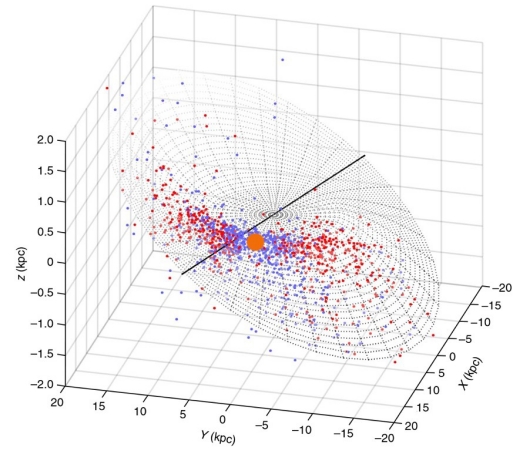
Image: The units ‘kpc’ (kiloparsecs) along the image’s three axes are used by astronomers to indicate distances on galaxy-wide scales. One kiloparsec is equivalent to about 3,262 light years. Credit: Chen et al.
The paper is Chen et al., “An intuitive 3D map of the Galactic warp’s precession traced by classical Cepheids,” Nature Astronomy 04 February 2019 (abstract). Thanks to Alex Tolley for useful information on this work.

Cassini Data on Saturn’s Rings, Clouds
Larry Klaes’ article on the film Silent Running, with its images of Saturn originally intended for 2001: A Space Odyssey, makes today’s story the obvious segue, and thus gives me the chance to catch up with some work I’ve been wanting to write about. For scientists using Cassini data have been able to zero in on the age of Saturn’s rings, an always lively area of controversy, with evidence that the rings formed between 10 million and 100 million years ago. The new analysis is discussed in the journal Science.
How to make such a call? Everything depends on getting a firmer fix on the mass of the rings, which in turn would tell us something about how bright individual ring particles must be. The brightness of the rings should have been affected by soot-like darkening inevitable over time. Fortunately, we had Cassini at Saturn to perform its so-called Grand Finale orbits, 22 dives between the planet and the rings. The gravitational effect of the rings went from being noise in data about the planet’s interior to a measurable quantity about both rings and host world.
“Only by getting so close to Saturn in Cassini’s final orbits were we able to gather the measurements to make the new discoveries,” said Cassini radio science team member and lead author Luciano Iess, of Sapienza University of Rome. “And with this work, Cassini fulfills a fundamental goal of its mission: not only to determine the mass of the rings, but to use the information to refine models and determine the age of the rings.”
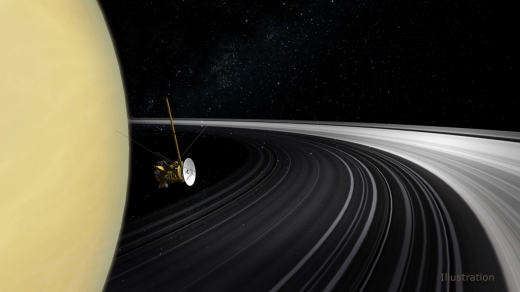
Image: An artist’s concept of the Cassini orbiter crossing Saturn’s ring plane. New measurements of the rings’ mass give scientists the best answer yet to the question of their age. Credit: NASA/JPL-Caltech
Think of Cassini in these orbits as a gravity probe, relaying data on its velocity and acceleration during its passage through Saturn’s gravity field. With acceleration pegged down to a fraction of a millimeter per second, the mass of the planet and its rings could be calculated. Even as we learn that the rings could be as young as 10 million years old, we also find that Saturn’s core has a mass in the range of 15 to 18 times that of Earth. Moreover, vibrations from within Saturn, still unexplained, warp the rings to create a pattern something like the spiral arms of a galaxy.
Iess’ work is actually part of a two-planet project using radio signals from both Cassini and Juno at Jupiter to probe gravitational variations inside the giant planets. The scientist was behind the creation of a radio instrument for Cassini that worked in the Ka band, where signals are largely unhampered by interference from interplanetary plasma. The intent was, among other things, to test general relativity during Cassini’s journey to Saturn. For most of the Cassini mission at Saturn, measuring tiny Doppler shifts in radio signals to study Saturn’s interior was problematic because of the rings, which is why the Grand Finale orbits have been such a game-changer.
Jupiter and Saturn make an interesting pairing for comparison and contrast. I’m looking at a chapter co-authored by Luciano Iess in a volume called Saturn in the 21st Century, written before the recent work. The overview is helpful:
While Jupiter is often thought of as the benchmark giant planet for this class of astrophysical object, now known to be abundant in the universe, Saturn provides an interesting point of comparison and departure for understanding giant planet structure and evolution… For instance, Jupiter models are highly sensitive to the equation of state (EOS, the relation between important quantities such as temperature, pressure and density) of hydrogen, the most abundant element in the universe, and thus can help to probe the phase space region around a few megabars and ten thousand Kelvin, for which accurate lab experimental data are not available yet. Saturn, on the other hand, with 30% of Jupiter’s mass, probes less of hydrogen’s phase space but has its own host of complex issues. With its peculiar magnetic field and high intrinsic luminosity, Saturn provides challenges to our understanding of the first-order properties that define a gas giant planet. For both planets, an understanding of their bulk composition can come from interior modeling, which is an important constraint on formation scenarios.
Radio fluctuations have been the key for mapping the gravity field at both Saturn and Jupiter, helping scientists learn about the deep interior. Comparing data for the two (the Jupiter data were released last year), the researchers found that while Jupiter’s core has an indeterminate boundary, Saturn’s core has a higher concentration of heavy elements, tentatively suggesting a better demarcated boundary. A key question: Does this have implications for the formation history of the two worlds?
Here I’ll quote Paul Voosen’s article in the January 17 Science:
Scientists once believed the gas giants formed much like Earth, building up a rocky core before vacuuming gas from the protoplanetary disc. Such a stately process would have likely led to distinct layers, including a discrete core enriched in heavier elements. But Juno’s measurements, interpreted through models, suggested Jupiter’s core has only a fuzzy boundary, its heavy elements tapering off for up to half its radius. This suggests that rather than forming a rocky core and then adding gas, Jupiter might have taken shape from vaporized rock and gas right from the start, says Nadine Nettelmann, a planetary scientist at the University of Rostock in Germany.
Interesting! And so are the differences between Saturn and Jupiter. Saturn’s equatorial atmosphere rotates around the planet faster than its inner layers and core. Only deep within the atmosphere do the layers rotate together, a trait Saturn shares with Jupiter. But the Cassini findings show that Saturn’s layers begin rotating in synchrony much deeper into the planet, as much as 9,000 kilometers down, or three times deeper than the same phenomenon at Jupiter.
“The discovery of deeply rotating layers is a surprising revelation about the internal structure of the planet,” said Cassini Project Scientist Linda Spilker of JPL. “The questions are what causes the more rapidly rotating part of the atmosphere to go so deep, and what does that tell us about Saturn’s interior?”
Even with the new work, we know all too little of Saturn’s deep interior, but so-called ‘ring seismology’ — using effects visible on the rings to draw conclusions about the atmosphere — is for the moment the best tool we have, at least until we get another spacecraft on the scene. As for the rings themselves, they’re losing material to Saturn, an indication of their relative transience. The rings may not have been in existence when the dinosaurs died. Will they be there at all in another 10 million years?
Paul Voosen’s article is “Missions expose surprising differences in the interiors of Saturn and Jupiter,” Science 17 January 2019 (full text). For the work on Jupiter, see Iess, et al., “Measurement of Jupiter’s Asymmetric Gravity Field,” Nature 555 (07 March 2018), 220-222 (abstract); and Guillot et al., “A Suppression of Differential Rotation in Jupiter’s Deep Interior,” Nature 555 (07 March 2018), 227-230 (abstract).

In Wildness is the Preservation of the World: ‘Silent Running’ and Our Choice of Futures
Centauri Dreams’ resident film critic Larry Klaes continues his in-depth look at science fiction movies with 1972’s Silent Running, whose protagonist is faced with a stark choice far from home. The film rode the era’s surging interest in environmentalism, and while overshadowed in the memory of many of us by 1968’s 2001: A Space Odyssey (and what SF film isn’t?), it has interesting connections with that film. Douglas Trumbull, who handled special effects for 2001, was the force behind Silent Running, and concepts originally envisioned for the former turned up in the latter, especially in the depiction of Saturn. How Saturn might have played into the earlier film — and why Jupiter took its place there — is just one of the historical avenues Larry explores in this wide-ranging essay.
By Larry Klaes
“On this first day of a new century, we humbly beg forgiveness and dedicate these last forests of our once beautiful nation to the hope that they will one day return and grace our foul Earth. Until that day may God bless these gardens and the brave men who care for them.”
Imagine that the environmental situation on Earth has gone bad – really bad. So bad, in fact, that the surviving remnants of our planet’s flora and some fauna have to be sent far away into deep space to ensure their continued existence, as their home world can no longer sustain them.
Dwelling under transparent pressurized geodesic domes attached to a fleet of converted commercial space freighters, the very last of Earth’s wildlife now circle the Sun in the vicinity of the ringed planet Saturn, averaging some 890 million miles from our yellow dwarf star. These biomes are cared for by a relatively small staff of trained personnel and ambulatory machines until the day they can be brought back home to repopulate and cleanse a planet devastated by the very beings who caused their near-extinction in the first place.
One naturally presumes that the very survival of the human race depends on the success of this ambitious plan. Certainly the stirring and seemingly heartfelt speech given by the fleet’s commander as the freighters left for the outer Sol system with their precious cargo eight years earlier strongly indicated as much.
Then one day the space fleet receives new orders: They are to eject all of their biodomes into space and destroy them by remote detonation with nuclear charges so that the freighters can be returned to much more profitable commercial service.
Is this the beginning of the end of all life on Earth? Is there no one left who cares enough to save the last forests – at any cost?
The Evolution of Silent Running

This is the essential plot and theme of the film Silent Running, first released to theaters in March of 1972. The genesis of Silent Running came largely from two seemingly disparate directions: What many consider to be the ultimate science fiction cinema, 2001: A Space Odyssey (1968), and the nascent environmental movement, with a heaping spoonful of the 1960s counterculture and the rise of science fiction celluloid with socially relevant messages.
Image: The original theatrical poster for the science fiction film Silent Running, released in 1972.
The man who would become both the producer and the director of Silent Running, Douglas Trumbull, came to fame as the special effects supervisor for 2001: A Space Odyssey, which was notable for its groundbreaking film effects. However, there was one effect that Trumbull and his team could not successfully accomplish with 1960s FX technology: A realistic visualization of the rings of Saturn.
Depicting that magnificent disc of particles circling the sixth planet from Sol was initially essential to the plot of 2001. Saturn was the original destination of the spaceship USS Discovery as described in the companion novel by Arthur C. Clarke, plot elements of which were based on earlier drafts of the film script, which Clarke co-authored with 2001 producer and director Stanley Kubrick.
Originally a purely space science mission, Discovery‘s goal was surreptitiously modified to encounter the alien beings (or perhaps their machinery) believed to dwell somewhere in the Saturn system after the finding of a large black Monolith buried on Earth’s moon. Uncovering the extraterrestrial artifact from the surrounding lunar regolith and exposing it to sunlight triggered a powerful automatic transmission aimed in the direction of the distant gas giant world.
The recipient of the lunar monolith’s signal turned out to be a much larger alien Monolith resting on the surface of the Saturnian moon Iapetus, a large natural satellite which was known to be an unusual object even in the first years after its discovery in 1671: One whole hemisphere is six times brighter than the other. Having scenes of Saturn looming in the sky when Discovery arrived there was essential: Showing Saturn without its ring system was basically having no Saturn at all.
Being unable to create what Trumbull felt was a convincing planetary ring, Discovery‘s celestial target was moved over 400 million miles closer to Sol, from Saturn to Jupiter, with the larger Monolith ending up moving freely among the Galilean moons.
This FX “defeat” set in motion Trumbull’s desire to successfully reproduce cinematically the rings of Saturn in a visually convincing fashion, even though the actual rings would not be seen or imaged closer than Earth-bound telescopes until the first space probe flybys over one decade after the premiere of 2001: A Space Odyssey. Thus the spaceships depicted in Silent Running would eventually wend their way to the Saturn system, rings included.
Earth Day Goes Interplanetary
Once Trumbull had the goal of creating a believable-looking set of rings for an otherwise fictional Saturn, the next task was to put an actual story around that world. One of the early plot concepts, as Trumbull would later relay to Fantastic Films magazine for their August, 1978 edition, retained the major elements of what would eventually become the final version of Silent Running: The spaceships with their biodomes, the lone “hero” fighting the will of a seemingly indifferent authority, the escape through the rings of Saturn, and the service robots or drones. One major new aspect which was later eliminated from the final story was an encounter with a visiting alien starship and its occupants.
However, this preliminary Silent Running outline lacked a deep reason, or heart, for being. The main character simply did not want to be forcibly retired from his job aboard the space freighter, as he enjoyed being alone in deep space away from the rest of humanity. As anyone who has seen Silent Running or just knows its premise, our designated hero is literally fighting the political/corporate decision makers single-handedly for the sake of all life on Earth.
Most of the initial plot draft involved escaping from the authorities who want this misogynist loner to quit and go back to Earth, his interactions with the drones, and attempting to make contact with the aforementioned ETI. The story ends with the main character being cornered and killed for conducting space piracy, while one of the service robots does get to meet the aliens – although the outcome of their initial interaction is deliberately left to the viewer’s imagination.
Around the time that Silent Running was first being put together, the organized environmental movement was just getting under way. The year 1970 saw both the very first Environmental Rights Day and Earth Day being held. These landmark public events were a peaceful reaction to the generations of pollution, resource depletion, and other manmade harms to the planet brought about by an ever-growing human populace and the vast technological civilization needed to support its numbers. Many people saw this decades-long combination of overpopulation, planetary poisoning, and the staggering nuclear arms buildup of the Cold War as the road to oblivion for humanity and most other terrestrial organisms if something was not done to halt this terminal journey immediately.
A great way to get out such a vital message to the general public was through the cinema, with its long proven power to grab and hold the attention of millions of people everywhere for several hours at a time. By embracing the theme of environmental salvation, Silent Running would become a noted part of the era of science fiction films with important social commentary, taking its place along with similar such films like Soylent Green (1973), which vividly imagined an overpopulated New York City in the year 2022, and Rollerball (1975) with its prediction of corporations running human civilization in place of governments in the year 2018, where they use a violent and deadly organized sport as a means not only to eliminate wasteful military conflict but also to placate and distract the citizenry while simultaneously teaching them the futility of individuality in their version of society.
This era of intelligent and intellectual science fiction celluloid would find itself seriously derailed, but thankfully never eliminated, with the arrival of Star Wars in 1977, which harked back to a simpler and ultimately much more financially profitable era of science fiction cinema known as the space opera. The science and technologies most often depicted in this type of science fiction film could best be described as science fantasy, where it is hard to determine when one has crossed over into the territory of supernatural magic and beings.
Another event taking place at the same time which had a surprisingly large influence on the environmental movement were the manned Apollo missions to Earth’s moon. Born as part of the geopolitical ambitions of the main participants of the aforementioned Cold War, the primary goal of Apollo was to place the first humans (preferably American citizens) on the lunar surface and bring them back alive along with invaluable scientific data about and regolith samples from our planet’s celestial companion.
One unexpected result from these voyages were the collective reactions to the images the Apollo astronauts returned of Earth as seen against the blackness of space from the distance of the Moon. From that novel perspective, our blue and white globe appeared as a beautiful yet fragile ball in need of our protection and care, especially when contrasted with the bleak, gray, cratered, and quite dead-looking lunar surface and the unrelenting cosmic darkness that surrounded both worlds. This sight was something the astronauts on those adventures noted multiple times, both during and after their space missions.
With the early Space Age “discovering” Earth for humanity, no doubt placing the terrestrial environmental issues of the day into the heavens for a literally and metaphorically heightened perspective seemed like the ideal “heart” for Silent Running‘s narrative. Nevertheless, as we will discuss, the film possesses a “split personality” regarding outer space and humanity’s exploration and utilization of this “Final Frontier”, which is highly reflective of the era it came from.
Did Silent Running help to build a bridge of understanding and appreciation between two cultures that generally did not meet eye-to-eye on what they think matters most for our species? Or did the film, intentionally or otherwise, merely widen the existing gap and follow in the footsteps of similar cinema of its time that rejected so much of what earlier generations took not just as part of everyday life but even a Manifest Destiny? Or did audiences just like the idea of watching one man having an entire hijacked space vessel to himself with a trio of cute little robots for companionship?
We will also examine the possibility that the main character of Silent Running is an idealized late Twentieth Century interpretation of the Nineteenth Century environmental and counter culture pioneer Henry David Thoreau projected into an imagined Twenty-First Century.
Our Story So Far…
In case you have yet to see Silent Running, or you have seen the film but want a memory refresher, this section contains a detailed plot summary to guide and aid in our discussion of this film’s issues. Seeing as Silent Running was released to the general public over forty-six years ago and you are here reading this essay for any number of reasons, the obligatory spoiler warning seems rather perfunctory.
That being said….
We open to a scene of a snail slowly wending its way up a green leaf in near-perfect time to a rather moving instrumental soundtrack. The scene pans out to show that this mollusk is living in what appears to be an arboretum at nightfall, where a robed man is tending to some of its flora and fauna. His gentle and attentive attitude makes it clear that he genuinely enjoys and cares about being here.
This peaceful, idyllic scene is suddenly and rudely interrupted by the very noisy and disruptive intrusion of three all-terrain vehicles, or ATVs, each driven by men whose idea of a good time is clearly in sharp contrast to the robed man, who angrily shouts at these interlopers to leave at once. He even hurls a rake at these unwelcome “visitors” in frustration as they tear up the precious and rare grass and other plants.
As we later follow these disparate set of men into their recreation and dining areas and listen to their conversations, we learn that they are the only human crew aboard a giant American Airlines space freighter named Valley Forge, which is just one of a fleet of similar vessels charged with a vitally important task: To preserve and safeguard these very last plants and animals of an Earth ravaged and ruined by human mismanagement and neglect. As we hear in a voiceover from the fleet commander named Anderson, these remnants of terrestrial biota held inside clusters of identical domed structures attached to each freighter are hoped to one day be returned to the planet “and grace our foul Earth.”

Image: Botanist Freeman Lowell prepares dinner for himself as seen from outside the American Airlines Space Freighter Valley Forge, which dwarfs him in comparison.
We learn that of the four crewmen of Valley Forge, only one really cares about their mission, the man one rather easily expects: Freeman Lowell, who was introduced as the robed character tending in the biodome.
Lowell is radically different from his fellow ship occupiers – John Keenan, Marty Barker, and Andy Wolf: Besides his obvious deep concern for the surviving Earth organisms, Lowell also grows and eats his own food planted in the biodome soil. The other men find the idea of a meal grown in the dirt rather unappetizing and would much rather eat the processed synthetic food provided by the ship via a dispensing unit.
The trio also do not quite grasp, nor do they really care, why Lowell carries on about the need to “refoliate the Earth”: After all, as one of them reminds Lowell, back home “…there’s hardly any more disease. There’s no more poverty. Nobody’s out of a job.” So who cares if some anonymous little girl, whose picture adorns a wall on their ship, is “never gonna be able to see the simple wonder of a leaf in her hand… because there’s not gonna be any trees,” as Lowell intones to them.
“If people were interested, something would have been done a long time ago,” is their final response on the matter.
Despite this prevailing attitude of apathy both on Valley Forge and seemingly everywhere else humanity resides, Lowell is still convinced that his eight years of dedication to the cause out in deep space in the vicinity of the gas giant planet Saturn (with those realistic looking rings), plus his undoubtedly constant pleas to the politicians and other authorities, will reestablish the parks and forest system with him as the most natural choice for its director. This is what Lowell believes will happen as they await an anticipated radio message from Earth about the fate of the entire project.
Instead, the authorities, represented by one Commander Anderson, have other plans:
“We have just received orders… to abandon, then nuclear destruct all the forests… and return our ships to commercial service. I have received no explanation, and we must begin at 0900 in the morning. May God have mercy on us all.”
Keenan, Barker, and Wolf are thrilled at this news, as they had already been “stuck” up there for six months with six more planned months to go. Lowell is quite understandably shocked at what he has heard. He demands and even begs his crewmates not to destroy the remaining forests:
“I don’t think you guys understand what this means. Please don’t blow up the domes… they’re not disposable… they’re not replaceable.”
All the other men can think of is going home to a world which not only has the aforementioned lack of disease and poverty but also “everywhere you go, the temperature is 75 degrees. Everything is the same. All the people are exactly the same.” The same attitude appears to hold for the crews of the other mission freighters as well, as we watch dome after dome being ejected into space and then detonated with nuclear charges (creating explosions which we and they are somehow able to hear despite being in airless and therefore audibly noiseless space).
Unable to allow this activity to continue, Lowell rushes to one of the last remaining domes ahead of Keenan, who arrives in an ATV to prepare the nuclear charges for their one and final act. Lowell tries to convince Keenan not to destroy the dome, but Keenan is only really interested in keeping to his schedule despite saying he knows how Lowell feels. Lowell responds by physically attacking and ultimately killing Keenan with a shovel, getting his right leg injured in the process. Lowell then rushes to remotely launch the other biodome where Barker and Wolf were setting up more charges, trapping them inside and then detonating the dome.
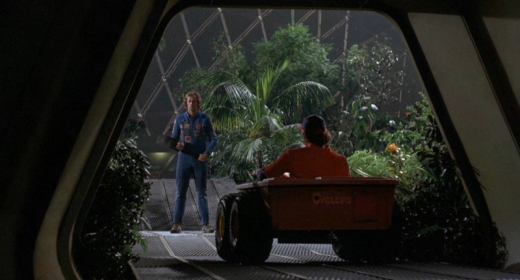
Image: Lowell confronts Keenan, determined not to let him destroy the last biodome with the remains of Earth’s macrolife.
Lowell goes to the command center of Valley Forge to concoct a plan to make it look like his spaceship had a serious accident and the freighter was now out of control. He radios to the sister freighter Berkshire and its captain “Big Billy” Neal that the rest of the crew were trapped inside a prematurely ejected dome while they were preparing it for destruction, being instantly killed by the resulting explosion. Lowell adds to the deception by ordering the ship’s three service drones to dump some of their cargo into space to make it look like Valley Forge had a hull breach. Lowell accelerates the ship towards Saturn in an effort to evade the rest of the fleet and protect the very last biodome.
Lowell is eventually contacted by the fleet’s commander, Anderson, who somberly informs him that Valley Forge is headed on a course that will cause it to “hit the northeastern quadrant of Saturn’s outer rings” early the next morning. Anderson is not convinced that Valley Forge will survive this encounter, as “these ships weren’t built to shoot the rapids.” When Lowell later tells Anderson that he could not fix the damage to divert the freighter away from Saturn’s rings, the commander says they will send out a search party in the event Lowell does survive the ring passage, even though recovering Valley Forge in the depths of interplanetary space might be “like [finding] a needle in a hay stack.” Anderson then tells Freeman Lowell that “you’re a hell of an American,” to which Lowell replies with “Thank you, sir. I think I am.”
Before Valley Forge runs into Saturn’s ring system, Lowell reprograms the service drones so they can perform an operation to help him repair his right leg injured in his fight with Keenan. Lowell also later reprograms the little robots to respond to new names: Huey, Dewey, and Louie, after the three nephews of the classic Walt Disney animated character Donald Duck.
As predicted and planned, Valley Forge plunges into the outer rings of Saturn, which for the sake of the ship, crew, and precious cargo seem to be not much worse in composition than a really heavy snow storm rather than the collection of ice boulders averaging three feet across which were determined during an actual planetary radar scan of the rings in 1970. Lowell, the biodome, and two of the three drones survive this experience: Poor Louie (formerly Drone Number 3), who was outside on the freighter’s hull during the “storm”, gets his foot trapped in a grate and is subsequently knocked off into space by ring particles, leaving his foot behind still stuck to the ship.
Emerging on the other side of Saturn and assuming he has outwitted and outmaneuvered the authorities, Lowell now tends to the business of preserving the living contents of the last biodome. First he has the drones help him bury the body of crewman Keenan in the soil floor of the dome. While Lowell pardons himself from being able to say a proper prayer over Keenan, he does perform a rough eulogy where he does not excuse his actions, but does add that he “had to do it.” Lowell concludes his little speech by declaring that while his former human crewmen “weren’t exactly [his] friends,” he “did like them.”
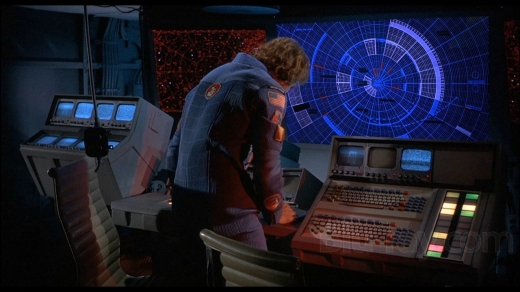
Image: Freeman Lowell in the command center of Valley Forge.
Lowell conducts further reprogramming of Huey and Dewey, both to assist in the caring of the biodome and to provide a level of companionship now that he is the only living human left on Valley Forge. Lowell also finds that his relative isolation and other burdens have caused him to act in ways that he had once criticized his fellow crewmen for, namely eating the synthetic foodstuffs and joyriding in an ATV.
It is this last activity which causes Lowell to accidentally collide the ATV into Huey, damaging the drone. Although Lowell is able to repair Huey to a degree, the robot’s abilities are now limited, leaving Dewey as the ship’s remaining fully functional service drone.
A bigger crisis occurs when Lowell discovers that the plants in the biodome are slowly dying. Despite being a professional botanist, Lowell is initially unable to determine what is causing the flora’s decline. Not even an unnamed “gray book” can help Lowell solve this serious problem.
Things take an even worse turn when Lowell is contacted by the space freighter Berkshire, which had continued to search for Lowell as Commander Anderson had promised and had found him at last. Just six hours away from docking, Anderson asks Lowell to find some way to jettison the Valley Forge’s remaining biodome, although he advises Lowell not to then detonate the dome as “it’s awfully dark out here” in this region of interplanetary space. This caution from Anderson gives Lowell – the botanist – a sudden epiphany: The plants need light to sustain themselves in a process called photosynthesis!
Lowell quickly sets up a collection of bright arc lamps around the interior of the dome in an effort to bring the flora back to health. He then instructs Dewey to tend to the forest from now on, while Lowell heads back into Valley Forge with Huey, who is too damaged to stay with Dewey and assist it in the dome.
Lowell launches the biodome into deep space, presumably safe from his fellow indifferent humans to await the day when the species wakes up and returns this last biota to Earth to start life there again.
Realizing he will have to answer to the authorities for his actions, Lowell sits on the floor with Huey and prepares the remaining nuclear charges. He tells the attentive drone that “when I was a kid, I put a note into a bottle, and it had my name and address on it. And then I threw the bottle into the ocean. And I never knew… if anybody ever found it.”

Image: Lowell sits with the damaged Huey aboard Valley Forge, preparing the nuclear charges for their final task.
We slowly move away from Lowell and Huey until we see Valley Forge from a distance in space. Suddenly the entire vessel becomes a huge expanding fireball just like the biodomes when they were deliberately destroyed.
All except one.
The final scene shows the last biodome drifting off into the cosmic darkness, its artificial lights peppering the dome like stars while Dewey poignantly maintains the surviving plants and animals of Earth into an unknown future, while Joan Baez sings in the background: “Tell them/It’s not too late/Cultivate/One by one/Tell them/To harvest/And rejoice/In the sun.”
First Things First
As a science fiction film, Silent Running certainly meets the cinematic goals of being entertaining, well-made, well-performed, and carrying a social message of significance. One can also include the words “memorable” and even “motivational”, as I have read more than a few testimonies from people who saw the film, especially when they were young, and never forgot it.
Being a lone hero fighting both seemingly insurmountable odds and people who “get” neither you personally nor your principles to save Earth and humanity from itself, all while conducting this righteous battle aboard a big spacecraft with some personable little robots as your programmable friends and compatriots, and the strong appeal of Silent Running to certain demographics is certainly understandable. Throw in the always photogenic cosmic standard Saturn and its magnificent set of rings looming in the background and you have the appearance of a near-perfect storm of a film for this genre.
Nevertheless, Silent Running is not without its flaws, some of them being rather large ones at that. I want to address them next because the levels of their transgressions warrant such a response. I also do not want them to ultimately detract from the main issues of this essay, though some of these do contain various amounts of relevance to the larger matters.
The Title
A good place to launch is the film’s title. I get that Silent Running refers to the concept of a ship operating as quietly as possible to evade detection by an enemy, especially in the case of submarines during wartime. Lowell does this to a degree with Valley Forge after he runs the ship through the rings of Saturn to convince the rest of the space freighter fleet that he was destroyed by the collision.
However, Lowell does little else to actually keep Valley Forge running silently or even attempt to somehow camouflage it out in the celestial darkness. It is apparent that Lowell thinks his deception plot combined with the vastness of the void will be enough to avoid the authorities.
I would not be surprised if Silent Running was an early title suggestion from the original story concept that the filmmakers simply stuck with through to the film’s release. The title is actually more relevant to the original plot outline: The main character had his robots help him “tear out all the communications equipment, throw it out into space, paint the whole ship totally black so no one can see it jet off. He’s constantly threatened by the fact that he could be pursued, that the authorities will be out looking for him. He’s a space pirate, and he’s having the time of his life,” as director Trumbull relayed to Fantastic Films magazine in 1978.
I also suspect Trumbull et al preferred the title as more “cool” sounding than something else that may have been more relevant to the final product but could have turned off and away certain audience demographics who might otherwise want to see a science fiction film, such as The Last Flower or No More Trees, or perhaps a phrase from one of the Joan Baez songs in the film’s soundtrack. Plus, there was already a contemporary film about environmental apocalypse titled No Blade of Grass, released in 1970.
In my research, I discovered that Italy relabeled Silent Running as 2002: The Second Odyssey on their film posters. The title certainly has a number of relevant attributes, not the least of them being a tie-in to 2001: A Space Odyssey with its contribution to the genesis of Silent Running. The year 2002 is also rather close to the actual then-future year that the film is supposed to take place, 2008.
No Plants and Animals Left on Earth – Really?
The background story of Silent Running is that humanity has so badly handled Earth’s biosphere that by the start of the Twenty-First Century, the only living terrestrial creatures left on the planet are humans (and most likely a variety of hardy microbes). The few surviving flora and fauna exist in clusters of geodesic domes attached to a fleet of converted commercial space freighters (all named after American national parks) circling the Sun in the vicinity of the planet Saturn. The plan is that one day these biota will be returned to Earth to rejuvenate the scarred globe.
Putting aside for the moment the incongruity of attempting to preserve Earth life over 800 million miles further from the Sun than what they have been used to since their ancestors first arose on our planet roughly four billion years ago: Exactly how did things get so bad on our world without wiping out the entire human race in the process? How could we survive on a planet without plants and animals in any event, both physically and psychologically?
I understand that this extreme scenario was created to shock and awaken the contemporary audience about the dire threats our technological civilization has created such as pollution and nuclear war. That message is no less urgent now. However, could humanity actually manage to survive such a loss to Earth’s biosphere?
While very little was actually said about conditions on the third planet from Sol, we did learn that the global surface temperature is 75 degrees Fahrenheit. This would mean a serious greenhouse effect that includes the permanent melting of all ice and snow everywhere, raising ocean levels and flooding coastlines and river banks. Earth’s entire atmosphere would presumably be unbreathable, dominated by carbon dioxide and numerous artificial toxins. The soil would be ruined by pollution and a severe lack of plants (with lots of landslides and dustbowl conditions), so humanity must either live in domed enclosures or underground facilities, or both. We know their food is manufactured, so the air and drinking water must be as well.
Living an entirely artificial existence in enclosed structures may sound like an oppressive nightmare, but think of how many of us in the civilized world already do this on a daily basis. Granted, most of us can go outside if and when we want to, but an increasing amount of our Twenty-First Century population often voluntarily prefers to remain indoors, setting aside the need to work and have a place to eat and sleep.
On a practical level, we could exist in domes or live underground, even if it seems like a rather inhuman and limited life. Judging by the thoughts and actions of three of the four humans we get to know in Silent Running, this artificial world appears to be preferable to the natural one, if for no other reason that Keenan, Barker, and Wolf have seldom known another way to live. Even their months of access and exposure to six large domes filled with a variety of biomes in each aboard the space freighter failed to sway them. Of course, if there are no other places with real terrestrial flora and fauna in the entire Sol system, they may have seen little point in getting attached to something that was not an important part of their lives before and may never encounter again.
One might also ask how and why did humanity allow conditions on Earth to become so terrible in the roughly three decades between the early 1970s when Silent Running was produced and released and January 1, 2000, when the freighter fleet was launched towards Saturn with its precious cargo of life (this latter date comes from the farewell speech by Anderson)?
Going along this same line, how did humanity manage in just under those same three decades to simultaneously “save” itself enough to remain on Earth despite the conditions there and develop what must be a fairly robust interplanetary infrastructure? Judging by the existence of an entire fleet of huge space freighters, there must be a number of sustainable space colonies and industrial bases (such as lunar and planetoid mining) already in existence to service and supply.
Nuking the Domes
Eliminating all life on Earth due to government and corporate greed and mismanagement combined with the malice, apathy, and ignorance of the general populace was bad enough: But then to take the one remaining effort to save what little was left of the terrestrial biome and literally blow it out of the sky just so the mission’s vessels and crews can be returned to undoubtedly much more financially profitable activities? In the words of our ambiguous hero Freeman Lowell: “It’s insane.”
Why would the authorities not only destroy the very last forests in existence, but do so in such an overreaching and complete manner with nuclear charges? For that matter, why would they leave multiple nuclear devices in the hands of the freighter crews with no obvious safeguards in place?
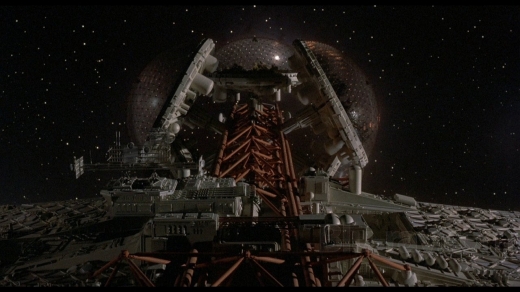
Image: The biodomes attached to the converted commercial space freighter Valley Forge, housing the very last flora and fauna from the planet Earth.
In terms of dramatic storytelling with the fact that Silent Running is a science fiction social message film, obliterating the biodomes with nuclear bombs is symbolic of what a nuclear war could do to every living creature on Earth. By the time of the film’s release, humanity had been under the threat of nuclear annihilation via the Cold War since the first atomic weapons were unleashed in 1945, with nuclear stockpiles steadily increasing on all sides with no end in sight.
Nuking all those domes with their innocent and unaware living occupants does indeed seem insane: There is good reason why the official term for global nuclear war, Mutually Assured Destruction, has the acronym of MAD. Any once hoped-for thoughts of one nation or another somehow “winning” such a conflict were rendered absurd well before the early 1970s. Everyone on Earth would suffer in one form or another from a nuclear conflict, whether they were directly involved and targeted or not.
Looking at the larger picture of getting rid of the domes in the context of the society of Silent Running, there are additional considerations in light of making the freighters financially solvent.
Although we are given few details on the interplanetary level of human civilization in this alternate Twenty-First Century reality, that commercial freighters are plying the spaceways as far out as Saturn indicates there must be a good deal of spacecraft traffic in the Sol system supplying industries and colonies. There are probably even some expeditions of space exploration, though they are likely done in the name of expanding corporate profits and government power as opposed to purely scientific missions.
Having a collection of large domed structures left wandering uncontrolled among the celestial neighborhood could be potential navigation hazards to the spaceships conducting legitimate business in an interplanetary society. Destroying them with nuclear bombs would ensure that their removal would be essentially complete, for even small space debris moving at high velocities can be highly dangerous.
In terms of the potential lethality from the radiation emitted by so many artificial nuclear explosions, considering how much natural cosmic radiation already permeates space in general, the relatively small amounts of additional radiation from the destruction of the biodomes would be negligible in comparison. Solar winds and other factors would also disperse it into the natural radiation background in short order.
Killing all those plants and animals are rendered no less criminal by these reasons, but for a society where the vast majority of its residents neither appreciate nor interact with such organisms and industry clearly holds sway over civilization, it does make a certain amount of pragmatic – if emotionally cold – sense.
There is another potential motive to removing the last biota so completely, one with a definite dystopian intent: If everyone now exists in prefabricated and controlled dwellings and they can no longer appreciate or care about wildlife — as represented by Keenan, Barker, and Wolf aboard Valley Forge – then getting rid of the last terrestrial organisms ensures that humanity will remain in and dependent upon their artificial environments, built and operated by the authorities – who are no doubt an intertwined entity of corporations and governments (Valley Forge is emblazoned with the words American Airlines Space Freighter on its hull and the logos of at least 24 real companies can be seen plastered on the many cargo modules in the ship’s hold).
The society of Silent Running may be quite similar to the one created by Aldous Huxley in his novel Brave New World (1932), where people are not oppressively controlled by some brutal totalitarian regime as in George Orwell’s novel 1984 (1948), but rather are given vent to all of their base needs while being steered away from nature, culture, true individuality, and even the traditional family unit. With the governing body, the State, providing everything for everyone – thus creating the illusion of true freedom – not only can the people not turn elsewhere to live and be governed, they voluntarily do not want to be anything anywhere else, until they can no longer conceive of another lifestyle as a viable option.
We do know that the society in Silent Running has conquered some of the biggest issues of human civilization since its beginning: Poverty and unemployment have been eradicated, with the elimination of all diseases soon to follow suit (all that and the global temperature is a comfy 75 degrees Fahrenheit). At the same time they provide sustenance and likely other basic needs at the literal press of a button.
It is little wonder that Keenan, Barker, and Wolf have no real interest in salvaging Earth’s biosphere: What has Nature ever done for them? For such a culture, having to live a life that involves procuring and eating food grown in the dirt would indeed seem both unsanitary and barbaric.
“Look at this crap! Look at that! Dried, synthetic crap!” shouts Lowell in frustration and disdain about the processed food dispensed aboard Valley Forge. “And you’ve become so dependent on it that I bet you can’t live without it.”
“Why do we want to, Lowell?” is their reply.
It is somewhat frustrating that Silent Running does not directly address these particular concepts outright for the sake of the film audiences’ edification: They had no issue grandstanding other related consequences of destroying the wilderness via Freeman Lowell. Granted, he did emphasize at one point that “everything is the same. All the people are exactly the same,” adding in the same speech to his three crewmates that “there is no more beauty, and there’s no more imagination. And there are no frontiers left to conquer. And you know why? Only one reason why… nobody cares.”
Nevertheless, knowing how this humanity must now have to live in order to survive, their type of government resulting from the collapse of Earth’s ecosystem makes a level of grim sense. This may not have been the initial intentional plan of the ruling bodies when Earth’s natural environment began to fail, but they undoubtedly took full advantage of the situation for near-total control once the human race was forced to live in artificial environments and gradually became used to it.
Since we are here speaking of the biodomes, an interesting little fact was pointed out in the “Goofs” section of the Silent Running page on the Internet Movie Database (IMDb):
https://www.imdb.com/title/tt0067756/goofs/?tab=gf&ref_=tt_trv_gf
“In all the forest domes, entry to the forest is shown to be through a tunnel in the rim of the dome. However, no connection of this kind can be seen in any of the exterior shots of the domes. Moreover, when the domes are jettisoned, the shots of the pylons connecting the domes to the ship reveal barely enough room for the ejection system engines. There does not seem to be any kind of connection which would indicate an access tunnel.”
While we can assume that the biodomes were not the usual cargo for the space freighters and were therefore not originally equipped to accommodate such structures, they would still require constant access by the human crew in order to be maintained over the eight years they were attached to those vessels. This would mandate the need for passageways or other conduits and there is certainly no denying such access ways exist – plus they were large enough for ATVs and cargo modules to pass through.
If someone with detailed plans for Valley Forge can figure out how the crew entered and exited the biodomes from the main ship via those triangular doorways in the bottom rims of the domes, let them speak. Otherwise we will have to bow once again to that Hollywood deity known as Dramatic and Creative Liberties.
Let There Be Light – For the Plants!
As mentioned in the plot summary for Silent Running, Lowell cannot determine why the plants in the last remaining biodome are dying until an unrelated comment from Anderson suddenly makes him realize that the plants are failing due to a lack of sunlight. Even his earlier consultation of an otherwise unnamed “gray book” on the subject gave him no clue to solve this “mystery.”
I am not the only one to point out that this lack of knowledge regarding basic plant physiology seems very peculiar for a character who is supposed to be a professional botanist. Even grade school attendees know (or should know) that most plants require solar or other forms of appropriate light energy to convert it into a chemical energy for fuel in a process known as photosynthesis. Perhaps this is why Lowell was passed over as director of the parks and forest system, assuming that government department had not already been abolished due to an acute lack of terrestrial parks and forest (yes, I am being largely facetious on the former statement here, but not the latter one).
There is also the possibility that the plants were being affected by cosmic radiation and solar flares, but I would like to think the makers of the biodomes would have accounted for these factors. How the domes are shielding the flora and fauna against these natural threats I am not certain: Are the transparent window segments in the domes made of some futuristic material that lets in sunlight but not cosmic radiation? I am going to assume there is no Star Trek style artificially generated “force field” surrounding the domes at least.
In terms of the film itself, Lowell’s ignorance of photosynthesis is probably a leftover from the original story outline where the main character had no defined expertise other than freighter maintainer and he was racing against time to make first contact with an alien starship and its occupants before the human authorities showed up. The filmmakers themselves should have been educated on this vital aspect of flora at some point in their lives, or at the least consulted with a real expert in the field, considering how key plants were to the story and how many real ones were used in the film.
Although I could not find anyone who was specifically credited for this, there must have been some “plant wranglers” who both procured the flora (and fauna) for Silent Running and then had to keep the set plants alive and thriving. Some of these production folks must have had a working knowledge of botany and plant husbandry (this was before Hollywood began acknowledging just about every single person who worked on a film in the end credits).

Image: Lowell tries to teach Dewey and Huey how to plant a tree in the biodome, with mixed results.
However, as we have seen with so many science fiction films over the decades, scientific accuracy is often not a key concern in the production process. Even such “hard” science fiction cinema as 2001: A Space Odyssey and The Martian (2015) had their moments of choosing story over accuracy, though the latter film did a much better job when it came to botany and plant physiology, and its main character, Mark Whatney, was a self-declared botanist who clearly knew his plants.
It is hardly impossible that the mystery behind the threat of demise for Earth’s last biota was added for extra dramatic effect as Lowell had to race against time once he did realize the cause before the sister freighter Berkshire arrived to “rescue” him. Keep in mind that after Lowell had emerged from Saturn’s rings and before he was found by Anderson et al, many scenes involved our main character either maintaining the biodome or finding various ways not to become fatally discouraged and bored. No doubt at some point the studio, Universal Pictures, wanted some dramatic tension, especially for the climax of the film.
Silent Running may have been an independent experimental art film to a certain degree, but Universal Pictures no doubt still wanted to make a profit from their investment. Art films that are too edgy and avant-garde tend not to produce those kind of results. If a professional botanist had to remain ignorant about plants needing sunlight to make food until the last few minutes, then so be it.
There is one other possibility as to why Lowell did not recognize the need for plants to have sunlight: He may have already thought they were getting enough energy from the artificial lights at the top of the biodome. The flora had remained alive for the last eight years with just these lights as part of their maintenance. So Lowell may have known about this basic principle of plant sustainability, saw that the dome lights were still working, and therefore sought out other possible reasons for their decline.
While Valley Forge was still out in the vicinity of Saturn even after Lowell’s “rescue” attempt, the ship’s violent interactions with the planet’s rings (there may have been some relevant vessel damage Lowell was not aware of and could not repair even if he did know) and subsequently moving even further away from the Sun to avoid detection may have combined to adversely affect the plants.
The Gravity of the Situation
Another scientific/technological mystery that has afflicted many a fictional space vessel is the matter of gravity: As in, how was the crew of Valley Forge able to remain firmly on the decks of the freighter in spite of the fact there was no obvious source or means of creating gravity?
Valley Forge was not spinning, either in whole or in part, to pull the crew against the designated floors. Neither was the freighter anywhere near large enough to have enough mass to match Earth levels of gravitational pull. I also have high doubts their society was advanced enough to develop artificial gravity for spaceships, whose methods are always left vague and currently defy our known laws of physics.
We shall chalk this mystery up to that other Hollywood deity, the one that declares depicting astronauts floating about in their ships as too complex and costly to reproduce on the big screen.
The Rings of Saturn
As we learned early on in this essay, the genesis of Silent Running came from Douglas Trumbull’s desire to accomplish what he could not do as the special effects supervisor for 2001: A Space Odyssey: Making a convincing effect of the most famous of all the celestial rings in our Sol system or any other, the ones circling the planet Saturn.

Image: This Japanese film poster of Silent Running depicts Drone Number 1 (a.k.a. Dewey) standing on the hull of Valley Forge, with the picturesque Saturn and its magnificent ring system in the background.
Trumbull did succeed in his goal and even made an entire and coherent film around them. The director and producer also did more than just keep Saturn and its ring system as a pretty and exotic backdrop: The rings became an integral part of the action and plot as Lowell decided to use them as an effective if potentially fatal way to escape the rest of the fleet by plunging Valley Forge into the “northeastern quadrant of Saturn’s outer rings” to make them think he would be destroyed in the process.
As Lowell rammed the freighter through the rings, it looked like Valley Forge was moving through the equivalent of an intense snow blizzard (which also made an incessant roaring noise in airless space). Surprisingly, the vessel did survive the encounter despite Anderson’s earlier warning that “these ships weren’t built to shoot the rapids.” Even the remaining biodome appeared unscathed from the shower of countless ice and dust particles.
There was one casualty, however: Louie (Drone Number 3), who was outside on Valley Forge’s hull with the other two service robots at the time. While obeying Lowell’s order to get back inside the ship, Louie’s foot became caught in a grate. Unable to free itself, the drone was subsequently either damaged or destroyed by the blast of ring particles, as Louie’s camera went offline just as it was knocked away into space.
I have the feeling that Louie was made the “sacrificial lamb” for this story segment not only to add some dramatic tension, but also because damaging the 25-foot long freighter model and full-scale sets to make them look like they had multiple cosmic hits would have been prohibitively expensive for the film budget, a contemporary one million US dollars, or almost six million US dollars in 2018 money. This is one-tenth of the overall cost of 2001: A Space Odyssey and a proverbial drop in the production budget for most films in this genre today.
All this leads to the singular question: Would a spaceship like Valley Forge (or just about any other kind of space vessel) actually survive a trip into and through the rings of Saturn?
As I mentioned in the plot summary, astronomers had conducted a radar survey of Saturn’s rings in 1970. They determined that the average ring element was about three feet across, with other dimensions ranging from dust particles to boulders the size of a house and larger. This is why NASA had the Cassini Saturn orbiter probe lead with its large fixed dish antenna like a shield when the robot explorer first encountered the planet in 2004. This is also why controllers did not allow Cassini to get very close to the ring system until 2017, the last year of its mission, before being deliberately plunged into the cloud tops of Saturn to prevent the biological contamination of any of the planet’s moons, particularly Enceladus and Titan.
Did the filmmakers know about this 1970 ring survey? If they did not pick up on plant photosynthesis, plus this was before the age of near-instant information communications, I am going to go with probably not.
As any astronaut who has been aboard a Space Shuttle or the International Space Station (ISS) can attest, even something as small and light as a paint fleck can cause noticeable damage to a spacecraft when moving at high velocities. Now imagine the potential harm inflicted by multiple ice boulders and we can understand why the filmmakers turned Saturn’s rings into a literal snow storm for Valley Forge: Strong enough to dislodge a little robot, but relatively safe for big space freighters, at least once.
Those Cute Little Robots
If there was one feature of Silent Running that the film’s fans like to focus on, it is the three service drones who performed maintenance duties on Valley Forge. Perhaps the most interesting aspect of Drones One, Two, and Three (whom Lowell later relabeled Huey, Dewey, and Louie, respectively) was their physical design. Not only did they look different from most other fictional cinematic and television robots, they also (mostly) acted like such machines might in reality.
George Lucas was so captivated by Huey, Dewey, and Louie that he had asked Trumbull’s permission to use their design as an inspiration and model for a particular mechanical being he had in mind for a film Lucas was developing called Star Wars. That robot became R2-D2, one of the most famous cinematic science fiction robots of all time. You can read the history of how Huey and its companions were the influence for R2-D2 here: https://kitbashed.com/blog/silent-running
I am a fan of the Valley Forge drones myself, in no small part because they give one the feeling that this is indeed how real robots on board a near-future spaceship might be built and function, even in a retro-future. They have no discernable faces, only equipment on their front sides that serve utilitarian purposes. In an ironic contrast, the small spherical robot currently aboard the ISS named CIMON has a computer display screen which projects a basic human face in order to make it easier for the station astronauts to interact with their new mechanical coworker. The drones also do not communicate in a spoken human language; instead, they use a series of chirps and other nonbiological noises primarily for and with each other.
The service drones also communicate with various limited physical gestures and postures, and this is where we run into some questions about their abilities. Several times throughout Silent Running, we witness the drones acting and responding to situations in ways that certainly seem to be the result of having some form of human-level emotions.
Examples include the way Huey and Dewey react to finding Louie’s foot still stuck to the freighter’s hull while they and Lowell were conducting an EVA, or extravehicular activity, sometime after the Saturn rings encounter. It is difficult not to label their physical posturing as mournful over losing their companion. Lowell’s reaction to their response further cements their behavior as particularly emotional.
Later on, when Lowell accidentally hits Huey with an ATV, Dewey refuses to leave Huey’s side as Lowell attempts to repair the damage he inflicted upon the drone. Dewey’s “body language” alone conveys concern, fear, and sadness in this situation, just as any human might. The two drones also seem rather intuitively adept at the card game of poker after Lowell programs them to be able to play the game with him. This includes an ability and willingness to cheat in order to win despite Lowell warning them against such an action. At another time, one drone was even seen to be tapping its artificial foot to express impatience and annoyance.
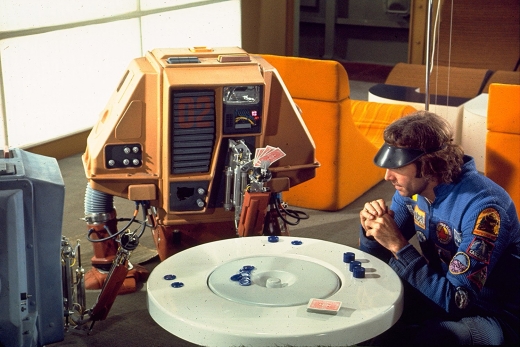
Image: To while away the days aboard Valley Forge, Lowell plays poker with the service drones Huey and Dewey; he reprogrammed them so they could play the game, which they learn to do very quickly and very well.
Could the drones possess actual emotions? Were they the result of Lowell’s extensive reprogramming to make them more versatile once the situation aboard Valley Forge radically changed? Or did these facets already exist as part of the drones’ original programming in order to make it easier for the human crew to deal with and command them as needed? In other words, were the behaviors we see in the drones which we interpret as emotional responses actually just part of their computer programming set in their assembly factories before being placed aboard the freighter? That as much as we, the film audience, may want and expect the three drones to have real feelings in situations just as most humans would, it is entirely possible, even plausible, that the little robots’ reactions are merely and purely the result of their preset computer coding, with no “ghost in the machine” present at all.
It can be difficult for the viewer to know the true state of the service drones in regards to having feelings and therefore emotions: Before Lowell killed the rest of the crew and hijacked Valley Forge, the drones are seen walking about the ship in the background and conducting their own business, having little interaction with the humans. Much of what we see when the drones play more prominent roles comes later in the film, after Lowell has reprogrammed them, sometimes with a soldering iron on their microchip boards!
The original tasks of the service drones were to maintain various technical functions on the space freighters. While such activities would involve a level of complex sophistication, they would not necessarily require an emotional component in order to succeed – unless the freighter company felt giving the drones some programmed emotional responses would make it easier for the human crew to work with them when called for.
That the drones were simply designated Drones One through Three and not once did we hear a crewman call them anything else, like a nickname, before Lowell later labeled them after Disney characters. This further indicates how little the humans regarded these robots as anything other than just another machine on the ship, as opposed to any sort of sentient being, even in a non-serious manner.
One set of assignments the drones were not originally called to perform were specific tasks for the biota in the domes. This explains the cute scene where Lowell tries to teach Huey and Dewey how to plant a young tree, with amusing and even touching results. Apparently Lowell did expect them to learn how to do this by observing what he said and did and then repeating the lesson. Does this mean the drones have some kind of learning algorithm in their computer brains? Is this from the factory installation program or something new given to them by Lowell?
Many folks of the late 1960s and early 1970s expected their species’ civilization to have both “smart” robots working everywhere and truly thinking Artificial Intelligences (AIs) by the early Twenty-First Century. We who live now in their future era know that the actual situation is far more challenging than it seemed then, though we do have a variety of robot “servants” and in certain areas of computer technology we have already exceeded even their imaginative dreams.
So do Huey, Dewey, and Louie have emotions largely because the makers of Silent Running felt it best to meet audience expectations? Or are they somehow actually conscious? Or were these robots just cleverly programmed to make it seem that way? Will we one day achieve a level of technology where we cannot tell the difference between programmed and genuine emotions for our machines? For that matter, how much are our emotions “real” as opposed to the result of ancient biological programming in response to certain stimuli and situations? Are we truly aware beings, or just think we are?
The Celestron Cameo
For anyone who has viewed Silent Running and possesses more than a casual interest in astronomy, it must have been a pleasant surprise with the scene where Lowell is in the biodome looking at a distant Earth through a moderate-size telescope with an orange tube.
That set “prop” was no prop, but a real astronomical instrument: The Celestron C8, a Schmidt-Cassegrain telescope introduced in 1970 by the Celestron company. The C8 became very popular not only with amateur astronomers but various industries and government institutions as well. This particular telescope model was manufactured and sold through the early 1980s. The number eight in C8 refers to the telescope’s aperture, the diameter (in inches) of the instrument’s main optical element.
If you want even more background on the Celestron C8, read here: http://scopereviews.com/C8History.html
As for Lowell viewing Earth through the C8, two questions come to mind (a third if you want to ask why they were using a telescope that was over three decades old from the story timeline perspective – not that telescopes cannot last and perform admirably for ages, please note):
The first question is, could a Celestron C8 offer such magnification of our planet from the distance of Saturn as shown in the film? While the telescope would probably be able to reveal that Earth is spherical, has phases, and even a much darker natural satellite as a celestial companion, I am not so certain that it could show any of our planet’s clouds, oceans, and land masses, at least certainly not in such detail – unless the telescope was equipped with some kind of advanced optics we were not made privy to.
The image the filmmakers used for Earth bears a very strong resemblance to the one taken by the American Apollo 8 crew when they became the first astronauts to circle Earth’s moon in December of 1968. Not only was this the first time that human beings (three in particular) personally witnessed their home world from the vicinity of the Moon, but their subsequently famous photographs of the beautiful and colorful Earth floating in the sea of black space were among the top catalysts for jump-starting the modern environmental movement as mentioned early on in this essay. So using this image as the only time we get to view the actual planet Earth in Silent Running is a symbolically appropriate one.
This leads to my second question: When we got to see what Lowell was seeing of Earth through that Celestron C8, we witnessed a planet cloaked in bright white clouds with clear blue oceans peeking through them.
Based on what we do know regarding conditions on Earth in this early Twenty-First Century, the entire globe should be heavily polluted and devoid of all living creatures save for humans, who would have to be surviving in either domed communities or dwelling beneath the surface, or both. In that case, I have my doubts Earth would appear so colorful and shiny, which would indicate a healthy and thriving planet. Instead, Earth’s surface should appear from space as a dark, bleak, and uninviting place, a world where something has clearly gone very wrong.
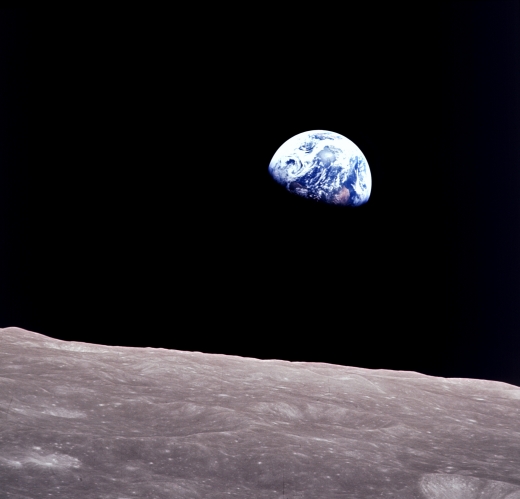
Image: Earth rising over the lunar surface as seen by the crew of Apollo 8 in December of 1968. This image and others from the Space Age played a role in inspiring the modern environmental movement.
Were the filmmakers concerned that contemporary audiences might not recognize their own planetary home if Earth were shown as anything other than the same kind of beautiful blue and white globe beamed back during the Apollo missions? Or did they just not consider the actual scenario at all when making this admittedly short film scene?
I wonder what Lowell was hoping to see while he was observing Earth? Or was he just using this opportunity to pass the time and think about his lost chance of returning home to become the director of the parks and forests system, where he would have played a prominent role in giving the children of the human species a chance to experience “…plains of tall, green grass that you could lie down in, that you could go to sleep in! And there were blue skies, and there was fresh air! And there were things growing all over the place, not just in domed enclosures blasted some millions of miles out into space!”
One final set of musings involving the Celestron C8: How often did the Valley Forge crew use this telescope, presumably for recreational purposes? Did they ever bother to observe the magnificent Saturn system they were privileged to be in the presence of, or any other celestial objects for that matter?
The likely sad answer to these questions is probably no, outside of perhaps a few initial glances out of sheer curiosity when they started their tours of duty. It was certainly evident that the crew neither cared nor truly appreciated that they were actually living and working in deep space, or especially that they were circling one of the most remarkable-looking planets in the Sol system. Even Lowell fell into this category, though at least in his case we know this is due to his single-minded focus on saving all terrestrial life and returning it back to Earth. Plus, Lowell had been out in space aboard Valley Forge for eight years, compared to Keenan, Barker, and Wolf, who had only been on the freighter for the past six months.
It is interesting how such a seemingly innocuous scene as a man looking through a telescope into space can ultimately tell us so much about the world of the film, inadvertently or otherwise.
A Cultural Game Changer? Or Just a Hippy Stuck in Space on a Cool-looking Ship with Robots?
I have always categorized Silent Running as one of the better-known science fiction films with a social message: In this particular case, to protect and save Earth’s ecosystem from human vice, greed, apathy, and ignorance. That much was easy enough, considering how loudly and prominently the film declared its intentions throughout.
I then further placed Silent Running into a subcategory of the genre: The science fiction film with the social message that takes place in outer space, where space is used as the bait to draw in the audience and then throw at them the real message, which may have little or nothing to do with or about space at all. Either that or the part involving space is actually a screed against the utilization of space by humanity.
This ploy was certainly not uncommon during the counterculture revolution that began in the 1960s, when many youth everywhere were rejecting the ideas and mores of earlier generations – and not without precedence. The wars of the Twentieth Century were the worst that humanity had yet seen, with the growing Cold War threatening to end civilization if not the entire species that created it. Nature was being increasingly paved over, poisoned, cut down, dug up, and otherwise destroyed to fulfill the relentless needs of a certain species of talking primate whose unchecked overbreeding threatened to overrun Earth like a virus. As for humanity itself, racism, sexism, and economic inequality were finally being called to the table, and there were genuine concerns that people were becoming more like the emotionless machines they feared were taking over their lives and especially their jobs.
Space exploration and utilization were not immune to this growing cultural shift. The technological and engineering roots of the major space powers came from World War 2, in particular from the use and study of captured V-2 rockets from Nazi Germany. The rockets that lofted the satellites of the Space Age were descendants of this and other military efforts: Most of these rockets were originally designed to deliver nuclear warheads to enemy targets, not study the stars. The majority of the first groups of astronauts and cosmonauts were predominantly chosen from the various branches of their respective military institutions. They were essentially cosmic warriors, not scientists and explorers. They were also overwhelmingly white and male.
Despite words and actions to the contrary, NASA and other space agencies seemed out of touch with everyday people and their worlds. It also did not help that many perceived the space effort as receiving an unfairly large amount of government funding over institutions with more terrestrial focuses, even though NASA share of government spending was always small in comparison to other federal agencies, including during the Apollo era. For some it was just enough that NASA was a part of the United States Government; they were part of the larger Establishment being fought against.
So when I first watched Silent Running, I observed a film where space was being used as a holding preserve for the last of Earth’s plants and animals, that the main protagonist wanted nothing more than to return home to reintroduce these life forms to save the planet, and that no one else in the story seemed to care about being in the Final Frontier or even just enjoy being there. It was not very difficult to make the assumption that the filmmakers and their targeted audience were the type that did not hesitate to agree with and chant that hoary old mantra about the money being spent on space should instead be spent on Earth and humanity.
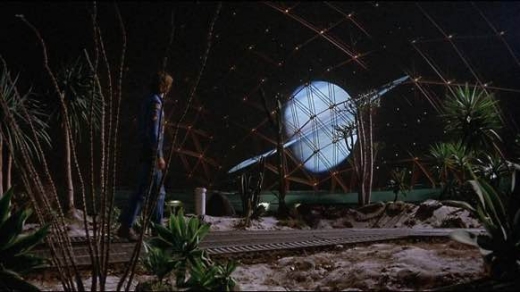
Image: Inside one of the Valley Forge biodomes, with Lowell looking at Saturn looming just outside in the depths of space.
As noted before, the perspective of our planet from the vantage point of space did play an important role in enlightening the masses to their home world as a finite body in a much vaster and largely unknown realm. However, I still saw what the astronauts beamed back to their fellow humans to be perceived by many as a means to an end that turned inward, rather than having space itself be the ultimate goal. Even public comments made by some of the astronauts who personally witnessed Earth from 240,000 miles away revealed their slant towards favoring their home world over the rest of the Universe in terms of where humanity should direct its energies.
I was pleasantly surprised to find in my research on Silent Running that Trumbull was deeply concerned about and subsequently inspired by the high levels of air and light pollution being emitted by the metropolis of Los Angeles: During the time when the film was being made, the city was infamous for its dangerous levels of smog due to growing automobile, truck, and industry emissions. The director recognized that these forms of pollution were keeping the populace from seeing the actual stars in their night sky and thus cutting them off from outer space, both physically and culturally. Trumbull felt that setting Silent Running in space, making the Final Frontier the ultimate “hero” that saves a future humanity from itself, would enlighten audiences that Earth and sky were not separate realms, but part of the same system of nature.
How well did this noble intent actually work in the end? Without directly polling those who have seen Silent Running, it can be hard to tell. However, if judged by the results of nearly a half century of time – and recognizing that one film – especially an “art” film that has achieved a level of cult status – then the results are perhaps mixed, which is not unsurprising.
Silent Running did influence a lot of future science fiction efforts which naturally in turn influenced other projects and those who watched them. In addition to the aforementioned Star Wars influence on R2-D2, Trumbull’s first directorial effort inspired the setting for the 2008 film WALL-E: A future Earth is literally trashed by humanity, which has been evacuated into interstellar space by a dominating megacorporation aboard giant starliners. The populace has lived in space in artificial luxury for centuries and become very dependent upon their machines. Other similarities between Silent Running and WALL-E include personable service robots which take care of most human needs and an initial plan to return to Earth to help it recover that had been deliberately held off by the corporation. Eventually the starship does return home and the humans and robots work together to clean up Earth and repopulate the planet.
The television series The Starlost, Red Dwarf, Battlestar Galactica (both versions) and Mystery Science Theater 3000 were also either inspired by Silent Running to portray their own take on a lone human stuck aboard a vast spaceship with only robots for companions, or reused the Valley Forge biodomes.
As for raising awareness to protect Earth’s environment, the fact that we are still living on the surface of our planet in relative safety, surrounded by flora and fauna rather than it only existing on some converted space freighters out by Saturn is definitely an accomplishment. Of course Silent Running did not really have a direct effect on this outcome simply because its scenario was just so extreme to begin with that we probably would not have survived such devastation to save even a few biota and launch them into interplanetary space.
As for Silent Running influencing the popular view of space as a place and goal for humanity, that may also be a decidedly mixed bag of results. Lowell’s three companions on Valley Forge certainly had no real interest or love in being out there: Space was just a job to them that they could not wait to be done with and go back home. Lowell himself of course was certainly less than pleased with the last nonhuman Earth life being “…in domed enclosures blasted some millions of miles out into space!” He had endured eight years aboard Valley Forge not only to safeguard and maintain the ship’s precious biodomes, but to prepare them for their rightful return to Earth to refoliate the planet.
When the authorities decided instead that the freighter fleet had more value as commercial space carriers than as elaborate and undoubtedly expensive greenhouses, this was meant to represent not just a personal and career failure for Lowell, but a cultural failure for humanity as a whole. That Lowell then had to rely on the dark vastness of interplanetary space to keep the last dome from destruction was literally cold comfort: Both he and the audience “instinctively” knew that an artificial structure in space “ain’t the kind of place/To raise your kids/In fact, it’s cold as hell/And there’s no one there to raise them/If you did,” as that space “expert” Elton John once sang in “Rocket Man” – just over a month after the release of Silent Running, for a fact.
I know the singer was referring to the planet Mars, but that world was just a representation of space as a whole as a lonely and unpleasant place to live and produce future generations (at the time, the Red Planet was the next logical goal in human space exploration after the Moon). These themes may have been counterculturally “cool” in the early 1970s, but they did little to help a lessening space program and agenda that just a few years earlier had been poised for greatness. That later science fiction films such as Dark Star (1974), the Alien franchise, and Gravity (2013) contributed to this image of space as boring, lonely, dangerous, deadly, and an extension of human vices and corruption and may have been influenced by Silent Running shows that Trumbull’s intentions were mostly lost, ironically by the very things he wanted to be seen as a positive game-changer.
Of course these conflicting thoughts and attitudes were in place long before Douglas Trumbull decided to depict Saturn rings convincingly. Our culture has long had a “split personality” which was labeled by British scientist and novelist C. P. Snow in 1959 as the Two Cultures.
In essence, society is generally divided along those who focus on the arts and humanities and those who prefer science and technology. While the two can, do, and sometimes must mix, often you will find that those who enjoy one side of the Two Cultures are often much less involved and interested in the other. This has led to a society that can seem quite ignorant on certain subjects, depending upon their preference, even if they are otherwise well educated. That this has had an effect on exploring and utilizing outer space, in particular with humans, in recent decades is evident.
Silent Running was a merger of the Two Cultures to a degree, but largely in the sense that art and special effects were used to portray plausible space technology. However, as stated before, the space freighter Valley Forge and its kin were not there to be a means to an end in terms of their actual purpose. As much as I want to say the film was positive in regards to humans being in space, especially after learning Trumbull’s intentions, I think that message got lost in between the intricately-detailed spaceship, the robots, and in particular the strong environmental message, with the latter being blared home by Lowell’s impassioned speeches and later actions and Joan Baez’s rather loud folk singing.
A similar result happened with the original film version of Rollerball, where many people were more interested in the game itself becoming a real sport than the social messages being delivered in the story. This was in sharp contrast to the desires of the film’s producer and director, Norman Jewison, who wanted viewers to be repulsed by the violence of this contact sport and the even darker meanings for its existence in that dystopia controlled by corporations.
While there are many fans who have become wrapped up in the details and minutiae of Valley Forge and its service robots – a hardly uncommon reaction by followers of many popular science fiction genres – I am not so certain how far that interest extends to the real space program. I would also have to question both how many of these same folks were also influenced to help save and protect Earth’s ecosystem to any significant degree.
Even more urgently, did those who watched Silent Running whose mindsets were more in the direction of a humanistic approach to such things as space and environmentalism, did they see space utilization as an important, even vital way to save life on Earth? Or did the concepts remain divided in their minds, where one should not or at least does not really need to relate to the other?
Perhaps a poll to resolve the above comments would be in order, though being conducted decades after the film’s premiere might invalidate the idea. If done with an early Twenty-First Century audience, their input might be “tainted” by a combined lack of direct experience with the era for many, the cloudy nostalgia and outright missing memories of those who were alive then and now recall those times from a distant chronological perspective, and the idealized warping of past times by later generations.
It is sadly safe to say that in most respects Silent Running‘s ecological message is still relevant today, if not more so, but how much can a film made decades ago and is known mostly by a niche audience have on affecting real environmental policies now?
Freeman Henry David Lowell Thoreau
On my most recent viewing of Silent Running, both to refresh my memory and gather ideas for this essay, I had one of those “lightbulb epiphany” moments. I was wondering who Freeman Lowell was based on, if any one real-life person was the inspiration for his character at all.
I could not find any concrete evidence for such an aspect of our film’s main protagonist; nevertheless, I had my suspicions as to where I had “seen” Lowell’s character before and this time it solidified into one name: Henry David Thoreau, a native of New England who lived from 1817 to 1862.

Image: Henry David Thoreau, from a daguerreotype taken in 1856.
Now Freeman Lowell is not an exact copy of the Nineteenth Century pioneering environmentalist and political activist, or probably any one individual for that matter. However, his character does appear to have been heavily influenced by Thoreau and then projected through the filter of the 1960s and 1970s environmental and counterculture movement – from which Thoreau and his ideas had been revived as one its early heroes and models.
One thing Thoreau has suffered from in the time since his death at the age of 44 is how he has been interpreted both by his contemporaries and the generations that followed them. The full picture of the man has long been incomplete: This has been due to both scholars and laypeople having only partial access to Thoreau’s life and works, and then taking what they want from these sources to serve their own agendas.
In the years just before Silent Running, there were several events regarding Thoreau that may have shaped popular thought on the man. One was the celebration of the 150th anniversary of his birth in 1967, which included Thoreau being commemorated on a United States postage stamp. Even more prominent and persuasive would have been the 1969 debut of a two-act played titled The Night Thoreau Spent in Jail, which recreated various moments of Thoreau’s early adult life, with an emphasis on his radicalism and activism. The title of the play refers to Thoreau briefly being incarcerated in 1846 for refusing to pay a poll tax because he did not want the money going to support either the Mexican-American War or slavery.
Thoreau did not fall into one easy definition of himself or the life he led, which so many often desire and even demand when trying to understand an individual. From his youth he stood out both in thought and in action. Thoreau often turned away from conventional human society, finding it vain, transitory, and more concerned with social status and acquiring money than the much larger and more ancient world around them: Nature.
One of Thoreau’s most famous quotes is: “…in Wildness is the preservation of the World,” from his essay “Walking,” published in The Atlantic just before his death in 1862. This is certainly a sentiment which Lowell would heartily agree with.
Despite most Americans making a living and experiencing an agricultural existence mainly through farming (and fishing and whaling to a lesser extent) in the Nineteenth Century, the Industrial Revolution that began a century earlier had caused an increasing number of people to move away from the rural life of the countryside and into the factories and offices of the cities. Thoreau witnessed his fellow citizens in these artificial settings turning away from nature and having “no time to be anything but a machine,” as he noted in the first chapter of his most famous work, Walden, published in 1854.
Thoreau also saw Native Americans being systematically driven from their lands by force and genocide across the continent. At the same time, the self-declared “land of the free” enslaved millions of African-Americans to white landowners and other businessmen. Their lives were not just an imitation of laboring machines, they were literal property in the eyes of the law with virtually no rights as fellow human beings.
Thoreau developed two solutions to these social ills: One was to cultivate a deep understanding and appreciation of the natural world. The other was to resist governments and other authorities whose rules and other actions were in opposition to the natural rights of the men and women they presumed to lead.
In regards to the latter, Thoreau is often best known for inspiring the likes of Mahatma Gandhi and Martin Luther King, Jr., to resist unlawful governments through peaceful actions from his other seminal work, which became known as Civil Disobedience (1849). Rather than a violent revolution to bring about social change as so often has happened throughout history, Thoreau advocated disobedience to these authorities by “simply” not obeying them, even if and when their reactions became harsh and often deadly. Many counterculture protests became what were known as “sit-ins”, among other similar terms, where protestors would literally sit and conduct passive resistance at public venues in response to the grievances they had over any number of social ills. Their presence and the reactions of the authorities to them were their speaking platforms and revolutionary actions.
One thing made quite clear from Silent Running is that Freeman Lowell spent most of his life attempting to work within the system legally fighting for what he believed in. Like Thoreau, our cinematic hero certainly did not fit into the standard mold of his society; this included advocating for saving Earth’s natural environment, which most other citizens of his era seemed to neither know nor care about.
However, when this civil approach had clearly failed, Lowell took another tack. Although Thoreau never actually went to the extreme measures that Lowell did to save the nature he loved and the oppressed humans he sided with, the author did advocate a more urgent strategy in his later years in a way that might surprise those who only know so much about the man, especially those who focus primarily on his nature writings.
Thoreau was a strong supporter of John Brown, a radical abolitionist who felt that the only way to truly end slavery in America was by physical force. Brown ultimately went so far as to amass a small army to raid the armory at Harper’s Ferry, Virginia, in 1859. The objective was to steal weapons and ammunition from the armory and then spread out into the countryside. Along the way, the group would attempt to free slaves to swell their numbers and to take down as many slave owners and their supporters as necessary in order to end this inhuman bondage nationwide.
The elaborate plan never got past taking the armory. Brown was wounded and captured in a standoff inside the armory. After a swift and prejudiced trial, he was executed by the state. Many Americans in both the Northern and the Southern states felt that Brown’s actions were too extreme, the behavior not of a hero and martyr, but those of a terrorist or raving lunatic. Even otherwise staunch abolitionists did not publicly support Brown. On the other hand, Thoreau wrote a speech titled “A Plea for Captain John Brown,” which made it clear where he stood on the matter: That when it came to ending such a vast and immoral institution as human slavery, strongly worded letters and peaceful protests were not going to be enough.
This revised attitude was also reflected in an entry Thoreau wrote in his Journal on December 9, 1859, just days after John Brown’s execution:
“Editors are still pretty generally saying that Brown’s was a ‘crazy scheme,’ and their one only evidence and proof of it is that it cost him his life. I have no doubt that, if he had gone with five thousand men, liberated a thousand slaves, killed a hundred or two slaveholders, and had as many more killed on his own side, but not lost his own life, such would have been prepared to call it by another name. Yet he has been far more successful than that. They seem to know nothing about living or dying for a principle.”
John Brown, and by extension, Henry David Thoreau, felt that their only recourse to save millions of fellow human beings was radical action. Thoreau had advocated and tried other much less extreme methods of persuasion and found them wanting. Although Brown had failed in his intended plan, his raid, combined with Thoreau’s supportive rhetoric, did play no minor role in the eventual freedom of the slaves, starting with the Emancipation Proclamation signed into federal law in 1863.
Freeman Lowell, who had dedicated the last eight years of his life aboard the converted space freighter Valley Forge to save what was left of Earth’s wilderness, had become certain that his undoubtedly constant stream of pleas and demands to the authorities would “finally bear some fruit.” Instead, the botanist learned to his shock that those in charge had no intention of ever preserving the precious contents of the biodomes and, by extension, life on Earth.
As Lowell watched in horror as the freighter fleet crews destroyed dome after dome with unbridled joy, he felt he had to do something radical in order to keep what would become the very last biodome from sharing the fate of all the others. It was quite literally a matter of life and death for every remaining human in the Sol system and the biosphere of Earth.
In Thoreau’s time, the slavery of African-Americans was seen by many white citizens as not only legal but even as the rightful order of both nature and God as they then perceived these concepts. In Lowell’s reality, for the vast majority of the human species, nature was a commodity at best and a general nuisance at worst. Does the majority view make them automatically right, or the relatively few people who see them as wrong legally, morally, and ethically?
Most of human society now sees slavery as a terrible and morally bankrupt concept, although it was a global institution for thousands of years and still exists in certain places, though certainly not at the scale it once was. The same may be said for protecting and fostering Earth’s ecosystem: Although there are still those organizations and individuals who use our planet’s natural resources for their own goals at its expense and do not either see or care about the wider picture of humanity’s interconnection with all other life, the overall consensus is that our environment is one that requires our protection and nurturing, often from our own growing civilization for our own sakes.
In regards to the society of Silent Running, we the audience are supposed to be rooting for Lowell and his one-man stand against a culture and system that do not cherish the natural world, even though they have found a way to somehow live without Earth’s ecosystem. This civilization has also found a way to overcome societal issues that still plague our reality, namely disease, poverty, and unemployment. They are also ahead of our society when it comes to space utilization and colonization: That very large manned space freighters are to be found in the vicinity of Saturn indicates a substantial self-sustaining culture throughout much of the Sol system.
Of course all this is really aimed at us, the audience who lives in a world where plants and animals still exists in relative abundance on a habitable Earth (yet we have not colonized a single world in our planetary neighborhood, with only scientific robots roaming about and just a handful of humans aboard the International Space Station in Earth orbit). Their artificial existence is supposed to be a warning not to destroy what we have, for even if losing nature does not kill us outright, surviving in a human-created and controlled society will destroy our souls and what makes us truly human, whether the inhabitants of such a place realize it or not.
Lowell tried to warn his fellow humans, just as Thoreau did through his books, essays, and lectures going on two centuries earlier. Both men were rather direct in their methods of admonishing society about what it was becoming, which can be effective in getting the key messages across. However, such bluntness can also backfire. Lowell was preaching to a group that had no strong reference to what he was saying and therefore it meant nothing to them (in the film at least).
Most of Thoreau’s societal and political tracts still have meaning and purchase roughly 150 years later. This shows their value and worth as informative lessons; yet, the fact that so many of his warnings are still valid to this day shows how far our civilization has to go if we do not want to end up with a ruined planet and a regressing humanity.
Was it wrong for Lowell to kill Keenan, Barker, and Wolf in order to save a forest, even if it was the last one left in their existence? Was it wrong for the majority of humanity in Silent Running to literally trash the planet of their birth and be eager to exterminate the final traces of its biosphere because they put more value in commerce than life itself? Was it wrong for Thoreau to advocate open rebellion when more pacifist methods fail as he did in his commentary on John Brown, especially if it means sacrificing a relatively small amount of people in order to save millions of others?
The easy way out to answer the above questions is to simply reply that it depends upon your point of view. The reality is that, whether you live in Lowell’s world or ours, there are billions of individuals existing as part of a larger organism called society. One might even go further and say that all life on Earth is part of a single massive living being which has been called Gaia. When a part of a body is defective in some way that can cause harm or even death to that body, the usual reaction is to remove that defective part. What does one do, though, when that defective part is not some cluster of cells or tissues, but a group of fully formed individuals with their own ways of being? Who wins out: The individuals or the body as a whole?
Perhaps on some alien worlds with beings who came about on an alternate evolutionary path, the answers to such questions there will be quite different, even irrelevant. However, just as the alien plot line was removed from the original story pitch for Silent Running, there are no extraterrestrial beings present in either Lowell’s world of 2008 or ours in 2018. They cannot guide us one way or the other except in speculation. As we have done for all of our existence up to this point, we have to find answers in ourselves and our world around us. We cannot wait for someone else to do the job for us, or take the responsibility from us. Other intelligences may not want the burden as it is. Or they may want to help us with the best of altruistic intents, only to discover that human issues are not truly compatible with truly alien minds.
Henry David Thoreau and Freeman Lowell both preached essentially the same warnings and the same solutions to humanity. That much has not changed, be it a century and a half or half a century later. It is now up to us how we treat our fellow beings, whether they are residing in a geodesic dome floating somewhere beyond Saturn and tended to by a lone little robot, or on an entire planet eight thousand miles across, circling a yellow dwarf star among an immense and ancient stellar island we call the Milky Way galaxy.
After the Cradle, Beyond the Biodome
In 1911, the great Soviet Russian rocket scientist and pioneer Konstantin Tsiolkovsky (1857 – 1935) famously wrote: “A planet is the cradle of mind, but one cannot live in a cradle forever” (the first half of this quote is often written as “Earth is the cradle of humanity”). Tsiolkovsky was a firm believer that humanity “will not always stay on Earth; the pursuit of light and space will lead him to penetrate the bounds of the atmosphere, timidly at first, but in the end to conquer the whole of solar space.” The space pioneer held this view so strongly that this quote became his epitaph.
Can biological humans survive and thrive in the Cosmos beyond Earth? If you go with the sentiments in Silent Running, the answer seems to be no, at least not without sacrificing their essential humanity if not their physical bodies. What will be left are complacent creatures in forms very similar to the ones named Keenan, Barker, and Wolf (and “Big Billy” Neal, represented by his words over the radio).
As Lowell pointed out regarding the human race and society in his version of the early Twenty-First Century: “Everything is the same. All the people are exactly the same. What kind of life is that?” Valley Forge’s resident contrarian then added that in his world, “there is no more beauty, and there’s no more imagination. And there are no frontiers left to conquer. And you know why? Only one reason why! One reason why! The same attitude that you three guys are giving me right here in this room today, and that is: Nobody cares.”
With these revelations, it is little wonder that Lowell appears so out of place there, far more than he would be in our world. This civilization’s artificial environment has not just turned its only remaining resident primates machinelike, they have no interest in responding to much of anything beyond basic needs and pleasures. This is why the service robots seem more human in comparison, or at least more compassionate and empathetic. Undoubtedly this attitude makes for a populace that is much easier to control and manipulate by the governing bodies.
Machines can do many things, often even better physically than humans. But it is the imagination, the spark of creativity, and the insights that will take us further to places we might never attain otherwise no matter how technically competent a machine or other forms of technology may be. Albert Einstein (1879 – 1955) did not say for nothing that “imagination is more important than knowledge. For knowledge is limited to all we now know and understand, while imagination embraces the entire world, stimulating progress, giving birth to evolution.”
Can the society shown in Silent Running ever truly evolve into something better than a species whose cultural highlights include joyriding in ATVs, playing pool (with a robot arm no less), and preferring synthetic food over organic? If they have abused and ignored not just Earth’s ecosystem but the ultimate natural environment around them – the Sol system and by extension the Universe, with all their wonders and riches – then how can they ever reach the stars literally, intellectually, and culturally?
The sad possibility is they just might expand into the Milky Way galaxy, but not so much as scientists and explorers as exploiters, especially once they have begun to use up the resources and spaces of their own Sol system. This materialism might happen to a degree even if they were appreciative of the wider cosmic world, but one gets the strong feeling that Lowell is the exception to the rule in their society, even though one might assume that odds alone would make his attitudes not so singular. However, one cannot ignore the fact that in his reality, there were not enough people left to stop first the degradation of the entire Earth and then the call for permanent removal of the last flora and fauna from their home planet.
I ask about what this removal of humanity’s soul will do not just to the human species overall, but also for that last biodome circling Sol, with its lonely service drone in attendance, poignantly tending to the plants with its child’s watering can as we watched the dome drifting off into the darkness and a future equally as lacking in illumination. If humanity cannot evolve in terms of understanding and compassion for others, did Lowell’s ultimate sacrifice only delay the inevitable original fate for the dome?
Will a future humanity come upon Valley Forge’s final biodome and simply disassemble it for whatever value this structure may bring? Will they look at the plants and animals – assuming they will have remained alive by then – first with puzzlement and then with apathy, leading them to their demise as the dome – along with faithful Dewey – is transported to some industrial facility for reintegration to support whatever material needs this society deems pertinent. The remaining pieces of the dome which offer no value to these descendants of humanity are discarded, left to float off into the void and eventual oblivion.
We want to think that the survival of the last dome represents hope in an otherwise dark and cold world, theirs and ours. It is certainly preferable to the alternative described above. That finding this utterly rare treasure from a world that once was will be the spark that reignites humanity’s imagination, passion, and caring. Realizing what they almost lost due to their ancestors’ greed and shortsightedness, the discoverers will transport the biodome back to Earth and refoliate the world with its contents, to much fanfare and joy.
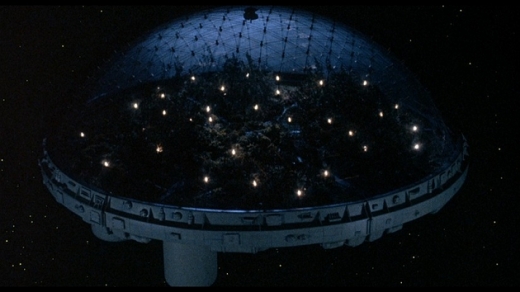
Image: The last biodome drifts off into an uncertain future.
Then slowly our home planet will be reborn, at last fulfilling Freeman Lowell’s wish that the descendants of the little girl whose face once graced the interior of Valley Forge will at last “be able to see the simple wonder of a leaf in [their] hand,” while they and all the others will know for themselves the “time when there were flowers all over the Earth! And there were valleys! And there were plains of tall, green grass that you could lie down in, that you could go to sleep in! And there were blue skies, and there was fresh air! And there were things growing all over the place!”
References
The following links take you to videos, articles, and essays for your further appreciation and enjoyment of the film Silent Running. These links were functional at the time of this essay’s publication.
The only free version of the complete Silent Running film I could find (and trust) online was at the Dailymotion site. The film has been deliberately faded to avoid any copyright issues. So while it is better than nothing, you may prefer to view the film in its proper form on Blu-ray.
https://www.dailymotion.com/video/x5tyer0
The official theatrical film trailer for Silent Running. One gets the impression that the people who made this trailer either did not entirely quite get what the film was about, or they were aiming to make it appealing to a wider audience. Perhaps both.
https://archive.org/details/SilentRunningTrailer
These are links to free transcripts of the film. Sadly, there are no stage directions and the spoken parts are not labeled.
https://www.scripts.com/script/silent_running_18138
https://www.springfieldspringfield.co.uk/movie_script.php?movie=silent-running
There are links to the Silent Running screenplay draft dated December 6, 1970, accessible from this next linked site. However, they are not free and I have not tested their validity. You have been warned.
https://scripts-onscreen.com/movie/silent-running-script-links/
This is an excellent Making Of documentary about Silent Running. While I wish it had gone into depth about the social and philosophical issues presented in the film, they did a nice professional job presenting what it took to make such a Hollywood film at that time. Especially interesting is the set they used for the space freighter Valley Forge: The Essex class aircraft carrier USS Valley Forge (CV-45), which served in the Korean and Vietnam Wars and had been decommissioned in 1969.
https://www.youtube.com/watch?v=9xtsNdLj1F4
The history of the USS Valley Forge, which the fictional space freighter was named after in honor of the very important role it served in making Silent Running possible (and under budget). In addition to its illustrious military service, I learned that the real Valley Forge was also involved with Operation Skyhook in 1960, where three giant balloons were launched from the ship’s deck high into Earth’s stratosphere carrying instruments to measure and record cosmic ray emissions. Later that same year, Valley Forge served as the primary recovery vessel for the Mercury-Redstone 1A unmanned spacecraft. This was a successful test mission as part of Project Mercury, which would take the first American astronauts into space in the early 1960s.
USS Valley Forge was sold for scrap just months after filming finished aboard the carrier in early 1971. There had been an attempt to turn the ship into a floating museum, but the plan failed to become a reality. At least the ship lives on through the film it helped make possible and has achieved a lasting fame in a way few other such vessels have.
https://en.wikipedia.org/wiki/USS_Valley_Forge_(CV-45)
This is a PDF file of an educational assignment asking students to examine and put into writing the ethical pros and cons of Lowell’s actions in Silent Running. Students are also assigned to examine and share their thoughts on other themes in the film such as the impact of the Industrial Revolution on Earth’s environment.
http://www.bfi.org.uk/sites/bfi.org.uk/files/downloads/silent-running-english-KS3-to-4.pdf
This valuable blog article goes into great detail on the history and design of the service drones with many images and artwork. Towards the end of this piece, there is a section on the original plot outline for Silent Running. The text contradicts some of the plot descriptions in the IMDB page on the film: Since it is a direct quote from the 1978 Fantastic Films magazine interview with Douglas Trumbull, I would trust this version over the latter. There is also an image and brief description of where the inspiration for the design of the space freighter Valley Forge came from: The Expo Tower from EXPO ’70 held in Osaka, Japan. The resemblance is easy to see in the accompanying photograph.
http://cyberneticzoo.com/not-quite-robots/1971-silent-running-drones-doug-trumbull-don-trumbull-paul-kraus-james-dow-american/
These next video clips show various keys scenes in Silent Running. Please note they are YouTube videos, so enjoy them while they still exist on that site.
Lowell prepares dinner while looking out a window in the galley. The scene then switches to the audience looking at Lowell from the other side of this same window. Slowly the camera pans out and away from this view. As we listen to Commander Anderson’s 2000 dedication speech for the last forests, we see that Lowell is aboard the American Airlines Space Freighter Valley Forge. This immense ship is part of a larger fleet of similar vessels all with the same mission: To protect and preserve the remaining wildernesses of planet Sol 3 in deep space until the day they can be brought back home “and grace our foul Earth.”
https://www.youtube.com/watch?v=Yq8y2aYX_8c
Joan Baez singing “Rejoice in the Sun”, with some nice accompanying scenes of the biodome interior, Valley Forge’s exterior, and the planet Saturn in the background:
https://www.youtube.com/watch?v=NkF05D-NJMU
Key scenes of the entire film:
https://www.youtube.com/watch?v=L2mFfFwWq-o
Lowell tries to get through to his crewmates one last time before they prepare to blow up the biodomes:
https://www.youtube.com/watch?v=6WVspvb3c3o
The drones performing surgery on Lowell’s injured leg after his fight with Keenan to stop the destruction of the very last biodome. Since they were using a real power cutting tool in the scene where the drone cuts off Lowell’s pant leg, actor Bruce Dern opted for a prosthetic “stunt” limb rather than his real one, just in case.
https://www.youtube.com/watch?v=8FM0j_NSWLg
The scene with Lowell preparing the nuclear charges to self-destruct Valley Forge before its sister space freighter Berkshire arrives. Damaged Huey watches and listens to Lowell talk about the time when he was a kid, he put a note in a bottle and threw it into the ocean, where he “never knew… if anybody ever found it.” Lowell is of course referring to the lone surviving biodome he had just ejected into space to save it from a callous contemporary humanity in the hope that some future generation with a much wiser mindset would find the last terrestrial wildlife and return it home to regreen Earth.
https://www.youtube.com/watch?v=Rt_fQvavqEA
The last scene of the film, with Dewey dutifully maintaining the forest as the dome containing it drifts off into the darkness:
https://www.youtube.com/watch?v=5_C5NIUu6FM
These next two sites contain lots of images, details, diagrams, artwork, and other information on the 25-foot model that represented Valley Forge, which was described as being two thousand feet long for the film. The model took six months to build, but only 1.5 hours to disassemble after filming was complete. There were plans by Universal Pictures to reassemble the space freighter model and take it on a studio publicity tour, but the model was deemed too fragile for such a terrestrial voyage (pieces of it kept falling off during filming). Today only a few of the biodomes still survive, preserved in various collections.
https://sketchucation.com/forums/viewtopic.php?t=35304
http://www.lunadude.com/pet_proj/valley_forge/index.html
Silent Running was one of the first Hollywood films to display real corporate logos in return for payment to be seen on screen. Several avid fans decided to find out just what companies were on those cargo module labels in the cargo hold of Valley Forge:
https://www.therpf.com/forums/threads/silent-running-valley-forge-cargo-module-logos.256770/
The various patches stitched on all over Freeman Lowell’s blue outfit also did not escape scrutiny by fans of the film:
https://www.therpf.com/forums/threads/silent-running-patches.104411/
Diagrams of all three service drones, Huey, Dewey, and Louie:
http://www.jackill.com/Pages/SR_Collection_Page1.htm
Some serious private model work on the drones, showing how each one had their own unique features:
http://www.bronsoncanyon.com/
This page goes into nice detail on the two poker games we see Lowell play in Silent Running, first with his fellow human crewmembers and then later with the service drones Huey and Dewey, which he successfully programmed to play the game. The article also discusses the wider meanings and implications of the poker scenes for the film.
https://www.pokerlistings.com/pop-poker-silent-running-takes-poker-into-space-96760&c=gIPTk1UPObhFPFv7FnyER_eptMNu01GWswStE5oAAZU&mkt=en-us
The scene where Lowell, Keenan, Barker, and Wolf play poker, with a matching dialog transcript below the video:
http://www.metacafe.com/watch/an-OwFV47YmhbJmm/silent_running_1972_the_poker_game/
The scene with Lowell playing poker with the two drones, including transcript:
http://www.metacafe.com/watch/7604894/silent_running_1972_playing_poker_with_the_drones_part_3/
Nice images and details on the food dispenser aboard Valley Forge, which provided the crew with what Lowell referred to as “dried, synthetic crap!”
http://nomnomovies.blogspot.com/2014/01/space-future-food-from-silent-running.html
Cinefex magazine Issue 8 (April, 1982) article focusing on Silent Running‘s special effects, the main people who made them and the film possible, and other production details. Written by Pamela Duncan (summary only online here):
http://www.cinefex.com/backissues/issue8.htm
This is the Internet Archive’s offering of the complete Silent Running music soundtrack:
https://archive.org/details/SilentRunning-1974Soundtrack-Vinyl24-bit
These next two links go to pages with details and ordering information on the Silent Running soundtrack. Joan Baez is the better known artist here and her two folk songs are now legendary – and somewhat infamous, depending upon whom you talk to about them. The instrumental numbers were created by Peter Schickele. His other claim to fame is as the creator of P. D. Q. Bach, a fictional composer whom Schickele envisioned as the “only forgotten son” of the prestigious and very real Bach music family. His works are satires and parodies on classical Western music.
http://store.intrada.com/s.nl/it.A/id.10636/.f
https://www.schickele.com/shoppe/psrec/silent.htm
An interview with Douglas Trumbull published in the December, 1978 issue of Starburst: Science Fantasy in Television, Cinema and Comics (Volume 1, Number 5), starting on page 34. The entire issue is online in PDF format here:
https://ia801602.us.archive.org/28/items/Starburst_Magazine_005_1978-12_Marvel-UK/Starburst_Magazine_005_1978-12_Marvel-UK.pdf
This is a 2014 interview with Douglas Trumbull on his body of work, which naturally includes Silent Running:
https://www.denofgeek.com/movies/31782/douglas-trumbull-interview-2001-silent-running-the-future-of-cinema
A look at some of the films and other entertainment inspired by Silent Running:
http://www.digitalspy.com/movies/news/a350038/silent-running-how-the-70s-classic-inspired-modern-sci-fi-movies/
Did Silent Running influence the creator of First Man, the 2018 film about astronaut Neil Armstrong, the first human being to walk on the surface of the Moon? This fellow seems to think so:
https://www.oxfordstudent.com/2018/12/03/the-quiet-science-fiction-film-silent-running/
Finally, my take on Silent Running from one decade ago in The Space Review, reflecting on an earlier article about the film from the same publication:
http://www.thespacereview.com/article/1337/1

AI Colonization: The Founder and the Ambassador
As we look toward future space missions using advanced artificial intelligence, when can we expect to have probes with cognitive capabilities similar to humans? Andreas Hein and Stephen Baxter consider the issue in their paper “Artificial Intelligence for Interstellar Travel” (citation below), working out mass estimates for the spacecraft and its subsystems and applying assumptions about the increase in computer power per payload mass. By 2050 we reach onboard data handling systems with a processing power of 15 million DMIPS per kg.
As DMIPS and flops are different performance measures [the computing power of the human brain is estimated at 1020 flops], we use a value for flops per kg from an existing supercomputer (MareNostrum) and extrapolate this value (0.025?1012 flops/kg) into the future (2050). By 2050, we assume an improvement of computational power by a factor 105 , which yields 0.025?1017 flops/kg. In order to achieve 1020 flops, a mass of dozens to a hundred tons is needed.
All of this factors into the discussion of what the authors call a ‘generic artificial intelligence probe.’ Including critical systems like solar cells and radiator mass, Hein and Baxter arrive at an AI probe massing on the order of hundreds of tons, which is not far off the value calculated in the 1970s for the Daedalus probe’s payload. Their figures sketch out a probe that will operate close to the target star, maximizing power intake for the artificial intelligence. Radiators are needed to reject the heat generated by the AI payload. The assumption is that AI will be switched off in cruise, there being no power source enroute to support its operations.
The computing payload itself masses 40 tons, with 100 tons for the radiator and 100 tons for solar cells. We can see the overall configuration in the image below, drawn from the paper.
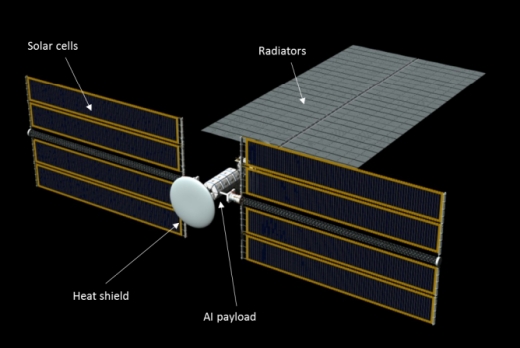
Image: This is Figure 10 from the paper. Caption: AI probe subsystems (Image: Adrian Mann).
Of course, all this points to increasingly powerful AI and smaller payloads over time. The authors comment:
Under the assumption that during the 2050 to 2090 timeframe, computing power per mass is still increasing by a factor of 20.5, it can be seen…that the payload mass decreases to levels that can be transported by an interstellar spacecraft of the size of the Daedalus probe or smaller from 2050 onwards. If the trend continues till 2090, even modest payload sizes of about 1 kg can be imagined. Such a mission might be subject to the ”waiting paradox”, as the development of the payload might be postponed successively, as long as computing power increases and consequently launch cost[s] decrease due to the lower payload mass.
And this is interesting: Let’s balance the capabilities of an advanced AI payload against the mass needed for transporting a human over interstellar distances (the latter being, in the authors’ estimation, about 100 tons). We reach a breakeven point for the AI probe with the cognitive capabilities of a human somewhere between 2050 and 2060. Of course, a human crew will mean more than a single individual on what would doubtless be a mission of colonization. And the capabilities of AI should continue to increase beyond 2060.
It’s intriguing that our first interstellar missions, perhaps in the form of Breakthrough Starshot’s tiny probes, are contemplated for this timeframe, at the same time that the development of AGI — artificial general intelligence — is extrapolated to occur around 2060. Moving well beyond this century, we can envision increasing miniaturization of increasingly capable AI and AGI, reducing the mass of an interstellar probe carrying such an intelligence to Starshot-sized payloads.
From Daedalus to a nano-probe is a long journey. It’s one that Robert Freitas investigated in a paper that took macro-scale Daedalus probes and folded in the idea of self-replication. He called the concept REPRO, a fusion-based design that would use local resources to produce a new REPRO probe every 500 years. But he would go on to contemplate probes no larger than sewing needles, each imbued with one or many AGIs and capable of using nanotechnology to activate assemblers, exploiting the surface resources of the objects found at destination.
As for Hein and Baxter, their taxonomy of AI probes, which we’ve partially examined this week, goes on to offer two more possibilities. The first is the ‘Founder’ probe, one able to alter its environment and establish human colonies. Thus a new form of human interstellar travel emerges. From the paper:
The classic application of a Founder-class probe may be the ‘seedship’ colony strategy. Crowl et al. [36] gave a recent sketch of possibilities for ‘embryo space colonisation’ (ESC). The purpose is to overcome the bottleneck costs of distance, mass, and energy associated with crewed interstellar voyages. Crowl et al. [36] suggested near-term strategies using frozen embryos, and more advanced options using artificial storage of genetic data and matterprinting of colonists’ bodies, and even ‘pantropy’, the pre-conception adaptation of the human form to local conditions. Hein [70] previously explored the possibility of using AI probes for downloading data from probes into assemblers that could recreate the colonists. Although appearing speculative, Boles et al. [18] have recently demonstrated the production of genetic code from data.
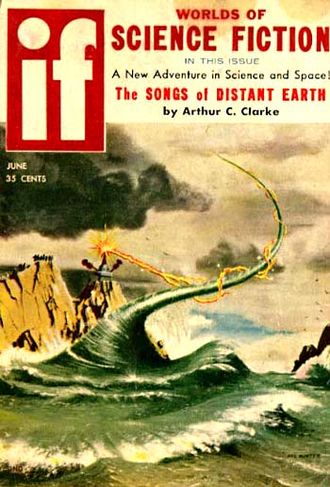
Founder probes demand capable AI indeed, for their job can include terraforming at destination (with all the ethical questions that raises) and the construction of human-ready habitats. You may recall, as the authors do, Arthur C. Clarke’s The Songs of Distant Earth (1986), wherein the Earth-like planet Thalassa is the colony site, and the first generation of colonists are raised by machines. Vernor Vinge imagines in a 1972 story called ‘Long Shot’ a mission carrying 10,000 human embryos, guided by a patient AI named Ilse. A key question for such concepts: Can natural parenting really be supplanted by AI, no matter how sophisticated?
Image: The cover of the June, 1958 issue of IF, featuring “The Songs of Distant Earth.” Science fiction has been exploring the issues raised by AGI for decades.
Taken to its speculative limit, the Founder probe is capable of digital to DNA conversion, which allows stem cells carried aboard the mission to be reprogrammed with DNA printed out from data aboard the probe or supplied from Earth. A new human colony is thus produced.
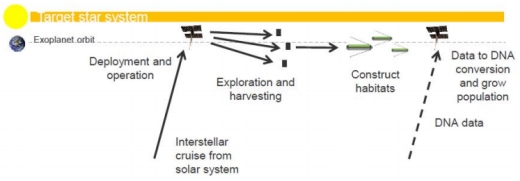
Image: This is Figure 9 from the paper. Caption: On-site production of genetic material via a data to DNA converter.
Hein and Baxter also explore what they call an ‘Ambassador’ probe. Here we’re in territory that dates back to Ronald Bracewell, who thought that a sufficiently advanced civilization could send out probes that would remain in a target stellar system until activated by its detection of technologies on a nearby planet. A number of advantages emerge when contrasted with the idea of long-range communications between stars:
A local probe would allow rapid dialogue, compared to an exchange of EM signals which might last millennia. The probe might even be able to contact cultures lacking advanced technology, through recognizing surface structures for example [11]. And if technological cultures are short-lived, a probe, if robust enough, can simply wait at a target star for a culture ready for contact to emerge – like the Monoliths of Clarke’s 2001 [32]. In Bracewell’s model, the probe would need to be capable of distinguishing between local signal types, interpreting incoming data, and of achieving dialogue in local languages in printed form – perhaps through the use of an animated dictionary mediated by television exchanges. In terms of message content, perhaps it would discuss advances in science and mathematics with us, or ‘write poetry or discuss philosophy’…
Are we in ‘Prime Directive’ territory here? Obviously we do not want to harm the local culture; there are planetary protection protocols to consider, and issues we’ve looked at before in terms of METI — Messaging Extraterrestrial Intelligence. The need for complex policy discussion before such probes could ever be launched is obvious. Clarke’s ‘Starglider’ probe (from The Fountains of Paradise) comes to mind, a visitor from another system that uses language skills acquired by radio leakage to begin exchanging information with humans.
Having run through their taxonomy, Hein and Baxter’s concept for a generic artificial intelligence probe, discussed earlier, assumes that future human-level AGI would consume as much energy for operations as the equivalent energy for simulating a human brain. Heat rejection turns out to be a major issue, as it is for supercomputers today, requiring the large radiators of the generic design. Protection from galactic cosmic rays during cruise, radiation-hardened electronics and self-healing technologies in hardware and software are a given for interstellar missions.
Frank Tipler, among others, has looked into the possibility of mind-uploading, which could theoretically take human intelligence along for the ride to the stars and, given the lack of biological crew, propel the colonization of the galaxy. Ray Kurzweil has gone even further,by suggesting that nano-probes of the Freitas variety might traverse wormholes for journeys across the universe. Such ideas are mind-bending (plenty of science fiction plots here), but it’s clear that given the length of the journeys we contemplate, finding non-biological agents to perform such missions will continue to occupy researchers at the boundaries of computation.
The paper is Hein & Baxter, “Artificial Intelligence for Interstellar Travel,” submitted to JBIS (preprint).


